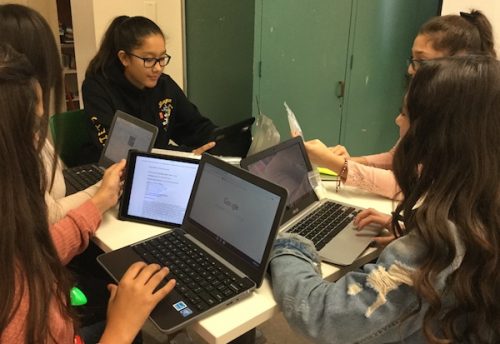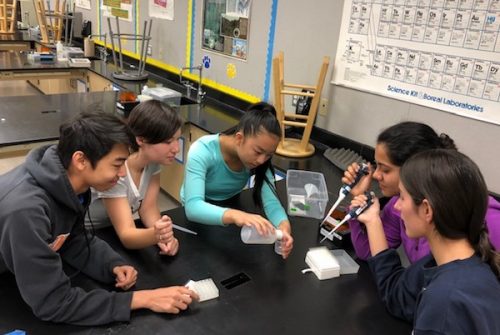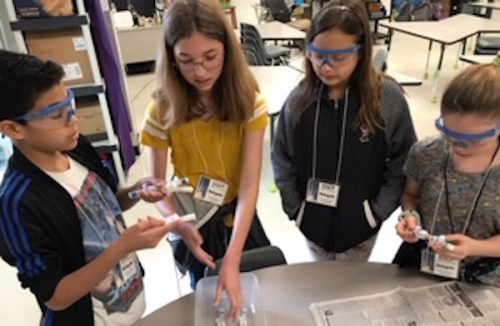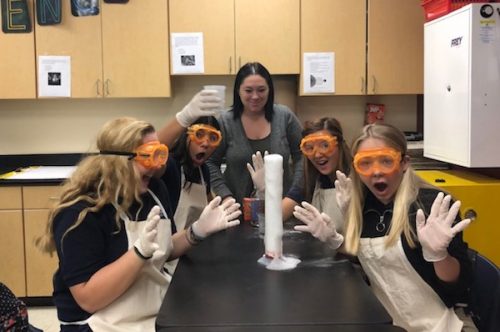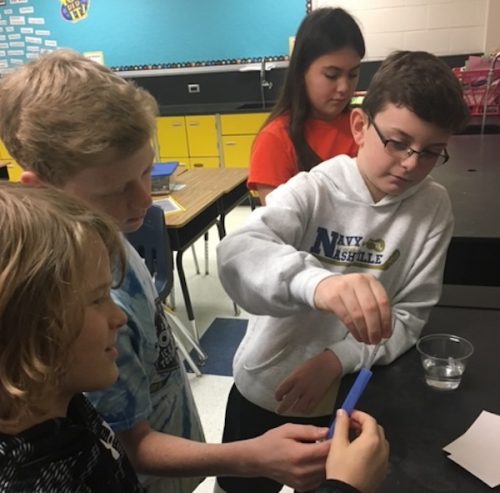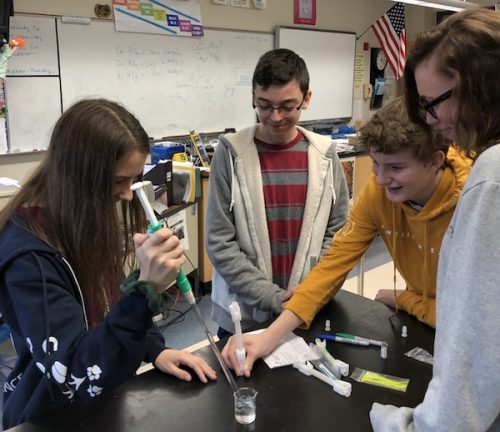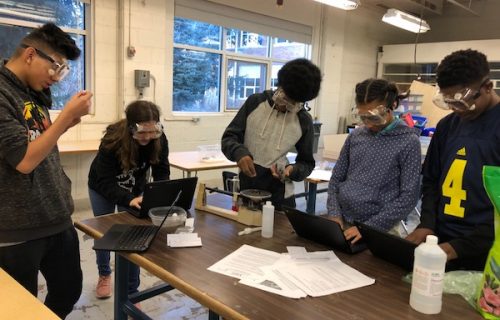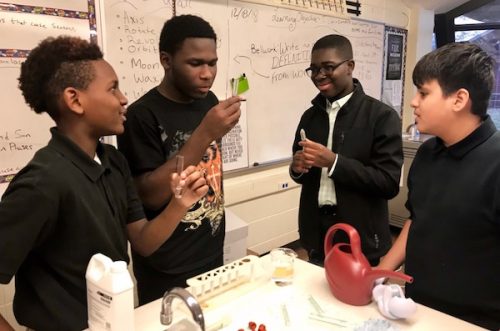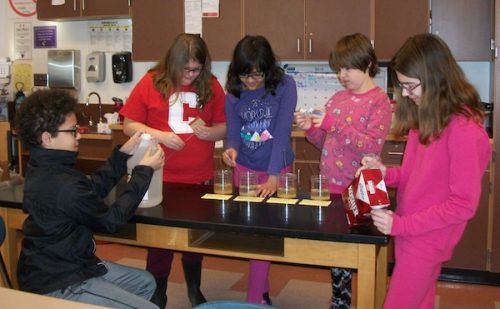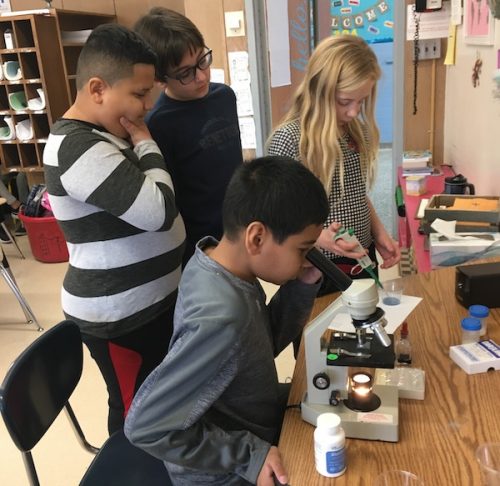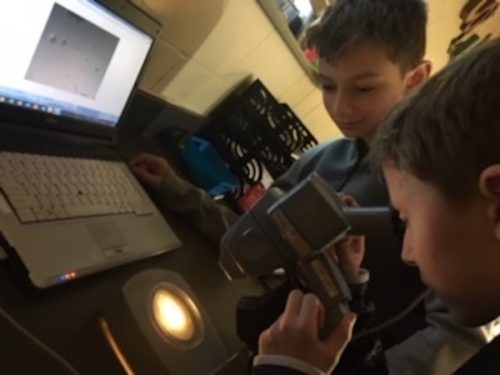The Student Spaceflight Experiments Program is proud to report that there were a total of 3,683 proposals submitted from student teams across the 38 communities participating in Mission 13 to ISS. Of those, 1,354 proposals were forwarded for review by Step 1 Review Boards in each of the communities. Each Step 1 Review Board selected up to three finalist proposals, which were submitted to the National SSEP Step 2 Review Board.
On November 29-30, 2018 the Step 2 Review Board met at the College Park Marriott Hotel and Conference Center in Hyattsville, MD, reviewed all 121 finalist proposals, and selected one proposed experiment to fly for 36 communities, three proposed experiments for one community and two proposed experiments for another community, for a total of 41 flight experiments. By December 17, 2018, the National Center for Earth and Space Science Education and the Arthur C. Clarke Institute for Space Education formally notified each community of their selected flight experiments.
It is noteworthy that the 3,683 proposals received reflected a total of 23,117 grade 5-16 students fully engaged in experiment design.
All 121 finalist experiment teams, along with descriptions of their proposed flight experiments, are provided below. You are also invited to meet the SSEP Step 2 Review Board members for Mission 13 to ISS.
Congratulations to the over 23,000 students and their teachers participating in Student Spaceflight Experiments Program Mission 13 to the International Space Station.
Quickly Scroll to Individual Communities
- Sao Paulo, Brazil
- Edmonton, Alberta, Canada
- Qualicum, British Columbia, Canada
- Winfield, Alabama
- Corcoran, California
- La Verne, California
- Moreno Valley, California
- North Hollywood, California
- Riverside, California
- Ashford/Willington, Connecticut
- Hillsborough County, Florida
- Port St. Lucie, Florida
- Berea, Kentucky
- Anne Arundel County, Maryland
- Montgomery County, Maryland
- University System of Maryland, Maryland
- Fitchburg, Massachusetts
- Redford, Michigan
- Traverse City, Michigan
- Kansas City, Missouri/Kansas
- Clark County, Nevada
- Galloway, New Jersey – Stockton University
- Ocean City, New Jersey
- Springfield, New Jersey
- Jefferson County, New York
- Suffolk County, New York
- WNY STEM – Buffalo/Niagara, New York
- Hunter, North Dakota
- Hershey, Pennsylvania – Milton Hershey School
- Pittsburgh, Pennsylvania – University of Pittsburgh
- Knox County, Tennessee
- Burleson, Texas
- Ector County, Texas
- Klein, Texas
- Marfa, Texas
- Pharr, Texas
- Raleigh County, West Virginia
- iForward – Grantsburg, Wisconsin
1. Sao Paulo, Brazil
Jump to Sao Paulo’s Community Profile
SELECTED FOR FLIGHT:
Capillarity versus Gravity in the Filtration Process
Grade 11, Instituto Federal de Santa Catarina – Câmpus Xanxerê
Co-Principal Investigators: Isabela Dalmolin Battistella, Renata Eliza Valentini Müller, Ricardo Vinícius Brum Cenci, Roberta Debortoli Moreira
Teacher Facilitator: Daniel Ecco
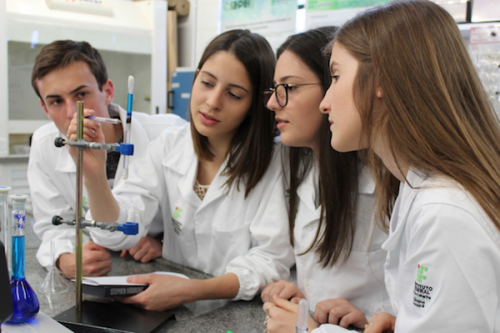
Students from IFSC-Xanxerê (Brazilian Community Winner) testing the capability of the active carbon filter – from left to right Ricardo Cenci, Roberta Debortoli, Renata Müller e Isabela Battistella.
Proposal Summary:
This proposal presents a water filtration system that uses activated carbon, based on the Brazilian clay filter’s operating method. It depends on gravity to work: the water is stored in its upper part and slowly passes through a candle-type activated carbon filter, leaving impurities behind. In the experiment, the activated carbon will be used as a filter for a solution of methylene blue (C16H18ClN3S) – chosen for its color and apolar characteristic – in distilled water. In the other volume of the FME, there will be a certain amount of cotton placed to absorb the solution to be filtered, due to the need to retain the liquid so that it does not return to the filter. The adapted filter is expected to work in microgravity by capillary action. In this proposal, we seek to adapt the filtration method to the conditions of microgravity environment, in order to find a filtering method that does not rely on gravity, and to observe its effectiveness regarding the same process when developed here on Earth under the action of gravity.
HONORABLE MENTION FINALISTS:
Interplanetary Plantation: The Influence of Microgravity in Cactus Seeds During a Trip to Mars
Grades 5 and 8, Escola Bosque
Principal Investigator: Guilherme Wolter Schirato
Co-Investigators: Guilherme Estavarengo Bernardo, Isabela Issahak Anca, Guilherme Olegário
Collaborator: Núbia Freire Delgado
Teacher Facilitator: Caroline Campos de Oliveira
Proposal Summary:
The idea of sending people on interplanetary missions is no longer science fiction, but the next and most challenging step of space missions. The challenges present themselves in the shape of long trips, permanence time, and possible return to Earth after the mission. Food production for the crew or animals, thinking of a possible colonization, is also among these different challenges. Food cultivation in planets like Mars, for example, would influence and assist in the transformation of its atmosphere (oxygen production) and soil (alteration of physicochemical proprieties). In this context, the goal for this project is to understand how seeds of different plants might survive and keep its characteristics during the trip to Mars. Microgravity is one of the main challenging conditions that these seeds would be exposed to in such a trip. Therefore, we plan to understand if microgravity will influence the characteristics and growth of the prickly pear cactus (Opuntia spp) after its seeds are exposed to microgravity at the International Space Station. Experimentally, the seeds will be exposed alone and in the presence of water, which will kick off the germination process of this seed, still in space. Once they’re back to Earth, both the seeds that went to space and the ones that remained on Earth (control group) will be secured in greenhouses and planted in two types of soil: Earth soil, and simulated Mars soil.
Microgravity Fermentation
Grades 6 and 8, Instituto Alpha Lumen, São José dos Campos- SP- Brazil
Co-Principal Investigators: Letícia Rodrigues Lage, Vinícius Augusto Landim Andrade, Ana Beatriz Ribeiro Bruno, Eduardo Simões de Mello, João Paulo Braga Correa
Teacher Facilitator: Juliana Alves Pires Biscuola
Proposal Summary:
Is it possible to accomplish an alcoholic fermentation in space? This experiment’s purpose is to just answer this question, analyzing the production of alcohol by decomposition of sucrose by the yeast Saccharomyces cerevisiae in microgravity. In anaerobic condition the yeast performs the alcoholic fermentation, producing enzymes that are capable of transforming sucrose molecules into glucose and later into ethanol and carbon dioxide. We know that, in a not too distant future there will be the possibility of very long space trips and will be necessary to use techniques previously tested to obtain answers to several questions that involve the survival of the crew. This way, we consider relevant the experimentation of fermentation in a microgravity environment, so it becomes an option for using of yeast for food and beverage production and for obtaining ethanol, an important representative of the organic alcohol function. Obtaining ethanol can also become an option for various applications in future space explorations, including raw material for new compounds.
2. Edmonton, Alberta, Canada
Jump to Edmonton’s Community Profile
SELECTED FOR FLIGHT:
The Effect of Microgravity on the Germination of Nasturtium Officinale (Watercress)
Grade 9, David Thomas King School, Edmonton Public Schools
Co-Principal Investigators: Lauren Clement, Deeanne Vergara
Co-Investigators: Thea Endols-Joa, Lily Hu
Collaborator: Kyra Lizotte
Teacher Facilitator: Kelsey Wasylenki
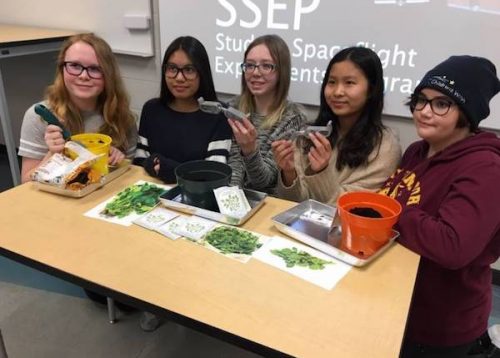
Students from David Thomas King School posing with their experiment materials for local media outlets. The team is testing the effects of microgravity on the germination of watercress seeds. From left to right: Lauren Clement, Deeanne Vergara, Thea Endols-Joa, Lily Hu and Kyra Lizotte.
Proposal Summary:
Our team is sending Nasturtium Officinale (watercress) seeds to the International Space Station to test the effects of microgravity on germination. If germination is successful, the watercress plant would be considered a food source for astronauts in space. If watercress could be added to their daily diets, it would make a big difference in the health of astronauts. Watercress has more Vitamin C than other food nutrition sources such as oranges, provides more iron than spinach, and has more folate than bananas. It also contains calcium, which is essential for bone and tissue growth. In addition, watercress carries vitamins A, B6, B12, as well as magnesium and phosphorous. These nutrients are all required for a healthy body and will be beneficial to astronauts. According to a study done by the University of Ulster, watercress prevents various types of cancer, such as bowel and breast cancer, as well as cognitive disorders, and strokes. In contrast, watercress increases healthy brain activity, acts as an antidepressant, reduces the chances of developing chronic heart disease, reduces oxidative damage to blood cells, and it can help maintain good eye health. If watercress is successfully germinated in microgravity, we would be able to send seeds up to the ISS for astronauts to grow as a food and nutrition source. Another advantage of watercress is the speed of its growth: from seed to mature plant takes between seven to fourteen days, which makes it an excellent choice for missions in space.
HONORABLE MENTION FINALISTS:
How Microgravity Affects the Survival Rate of INS-1 Cells
Grade 9, Elizabeth Finch School, Edmonton Public Schools
Co-Principal Investigators: Tanner Hillaby, Ruth Moges, Aleeza Valani
Investigator: Maisun El-Sharik
Collaborators: Paul Le, Dajana Naveed
Teacher Facilitator: Jennifer Wallace
Proposal Summary:
Our proposal is to see if microgravity will have an effect on the survival rate of INS-1 cells; cells responsible for insulin production. According to the 2013 study by Space Research Manager at the University of Waterloo, Danielle Greaves, after a long duration in space, Chris Hadfield and other astronauts experienced symptoms of Type 2 diabetes. It was caused by their sedentary lifestyle in microgravity (Ivan Semeniuk, 2018). This experiment has not been performed in microgravity, so our hope is that conducting this experiment will deepen our understanding of beta cell behaviour here on Earth and in a micro-gravitational environment. With the information we receive from the experiment, we can learn more about beta cell death. This knowledge may lead to new treatments for people with Type 2 diabetes on Earth and for future space travel. We predict that microgravity will cause the INS-1 cells to produce a lot of insulin causing many to burn out from exhaustion and die.
Effectiveness and SPF of Sunscreen After Being in Space
Grade 8, Michael Strembitsky School, Edmonton Public Schools
Co-Principal Investigators: Hannah Mckay, Tessa Pratt, Daymon Sanderson
Teacher Facilitator: Julie Arsenault
Proposal Summary:
This experiment will be testing two types of sunscreens to see if they have the same protection against UVA and UVB back on Earth after being exposed to extreme levels of cosmic radiation and microgravity on the ISS. On Earth, our atmosphere protects us from harsh radiation and on the ISS there is less protection from UV and other cosmic rays. UVB rays are the main cause of sunburn, while UVA rays cause deeper damage to the skin such as wrinkling and early aging. In our experiment, we will use both chemical and physical sunscreens with the same SPF. Chemical sunscreen absorbs into the epidermis and dermis to protect skin by absorbing the UV rays. Physical sunscreen creates a barrier between your skin and UV light thus reflecting the rays. We will put the physical and chemical sunscreens in a type 2 FME mini lab when it is sent to the ISS, while keeping a second mini lab with the same sunscreens here on Earth. The Earth lab will be kept on a windowsill to expose it to normal amounts of UV rays. When the FME lab returns, we will use a UV-vis Spectrophotometer and UV beads to test the sunscreens’ abilities to absorb or reflect UV rays. In the future, when more people are in space including missions to revisit the Moon and colonize Mars, people will need sunscreen to protect themselves from the harsh ultraviolet radiation that is abundant where there is no protection from the atmosphere.
3. Qualicum, British Columbia, Canada
Jump to Qualicum’s Community Profile
SELECTED FOR FLIGHT:
Investigating the Growth Patterns of Alfalfa (Medicago sativa) Sprouts in Microgravity: a Potential Nourishment for Future Manned Spaceflights
Grades 11-12, École Ballenas Secondary, School District 69
Co-Principal Investigators: Marco Ioffredi, Victor Kamel, Robert Lachance, Alexander Marshall, Filipe Pereira
Teacher Facilitator: Carl Savage
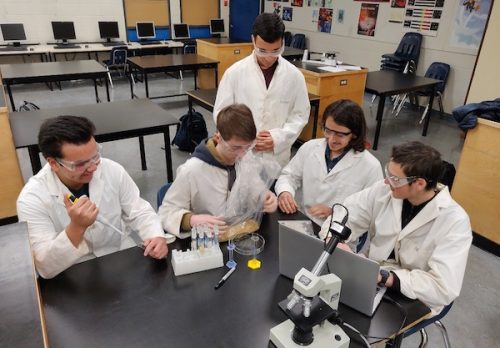
School District 69 (Qualicum) team members Robert Lachance, Alexander Marshall, Filipe Pereira, Marco Ioffredi and Victor Kamel, preparing their experiment for the trip to the International Space Station.
Proposal Summary:
When humans venture beyond Earth’s orbit on to Mars, horticulture will surely follow (Wheeler, 2002). No doubt, plants will have a crucial role in future spaceflights and colonization, both as food and as part of regenerative life support systems. In particular, Medicago sativa (Alfalfa) sprouts may be a great resource for astronauts given their nutritional benefits, being a crucial supply of macronutrients for humans in microgravity and in the prevention of microgravity-related diseases (USDA, 2018; Joint, F.A.O & W.H.O., 1998). As one of the most cultivated legumes in the world, Alfalfa is cost effective and easy to obtain. (Bora & Sharma, 2011). The experiment will be performed in a Type 3 FME mini lab: in Volume 1 there will be distilled water, Volume 2 will contain Alfalfa seeds, and Volume 3 a 10% formalin solution acting as a fixative. Comparing germination rate, root length, cross sectional area, volume, and collective mass between the ground control and the experiment in microgravity with a computer aided microscopic imaging device and high precision scale, the experiment will attempt to demonstrate how Alfalfa sprouts react to the conditions in space. Barely any research has been previously done on the behaviour of Alfalfa in microgravity. This experiment could provide the scientific community with data that could allow further investigation into how Alfalfa seeds germinate in microgravity to eventually confirm its potential in future long-term spaceflights and extra-terrestrial settlement. Further, the ISS would serve as a unique laboratory to conduct such research and gather important data.
HONORABLE MENTION FINALISTS:
The Growth Rate and Pattern of Bacteria (Bacillus subtilis) in a Microgravity Environment
Grades 9-10 and 12, École Ballenas Secondary, School District 69
Principal Investigator: Amanda Litton
Co-Investigators: David Downey, Caitlin Holme, Connor Litton, Nasuka Nakazawa
Teacher Facilitator: Carl Savage
Proposal Summary:
Bacteria is a key factor to life on Earth. It is a primary decomposer as well as a prime recycler for chemical elements, including nitrogen and carbon. It is incredibly important to life on Earth and could lead to resolving issues aboard the ISS. The goal will be to send the bacteria, Bacillus subtilis, to the ISS to monitor how microgravity affects the growth rate and growth patterns of the bacteria. Bacillus subtilis was the perfect bacteria to send because it provides little risk to humans, is easily accessible and will be able to grow in an environment which the temperature is 23.9° Celsius, this is the same temperature as the ISS. The same experiment will be conducted on Earth and the results will be compared. If successful, other bacteria, such as Methanosarcina acetivorans, could be sent to the ISS in the future to help solve problems. Methanosarcina acetivorans, is a decomposer that produces a gas that is flammable (Science Direct, 2018). This could be used to resolve the problem of disposing of unwanted organic waste. Instead of sending it all the way back to Earth, it could be broken down on the ISS. It would help reduce the waste that would be sent down and the byproduct, methane, could be collected and used as a fuel source. However, before looking into these possibilities, Bacillus subtilis must be studied to determine whether the growth rate and growth patterns may change in a microgravity environment.
Will Mold Grow Differently on Bread in a Microgravity Zone?
Grades 5-6, Arrowview Elementary School, School District 69
Co-Principal Investigators: Emily Anderson, Avalon Carey, Liam Einarson, Ethan Gamble, Joshua Gauvin, Evin Izdebski, Novie Pratte, Damien Roberts, Karli Taylor, Jacob Waitson
Teacher Facilitator: Karen Tickell
Proposal Summary:
The question we are focusing on is whether mold will grow differently in a microgravity environment. Our group chose to do bread mold, because bread substances mold quickly. Mold cannot grow on oily substances. Some main types of mold are cladosporium, rhizopus stolonifera, and penicillin. Some are dangerous and some have healing abilities. Mold can be harmful to people, plants, and animals. In some cases mold can cause disorientation, sneezing, itchy eyes, nose, and throat, and postnasal drip. This can lead to unfortunate events, especially on a spacecraft. Our experiment will use one of the two FME 3 mini labs, one for on the space station and one for our control experiment here at our school. In our experiment, Volume 1 will have 0.5cm X 3.0cm of Dutch whole wheat bread. Volume 2 will be water 2 ml of tap water from the town of Qualicum water system with the PH measured prior to adding the sample to the control and ISS tubes. Volume 3 will be the fixative 10% neutral-buffered formalin. Once the experiment comes back to Earth, we will analyze the results with a camera, microscope, ruler, and centimeter grid.
4. Winfield, Alabama
Jump to Winfield’s Community Profile
SELECTED FOR FLIGHT:
Purification of Water in Microgravity
Grade 12, Winfield City High School, Winfield City Schools
Co-Principal Investigators: Luke Clark, Tanner Edmond, Davis Holdbrooks, Luke Jungels, Savannah Williamson
Teacher Facilitator: Jennifer Birmingham
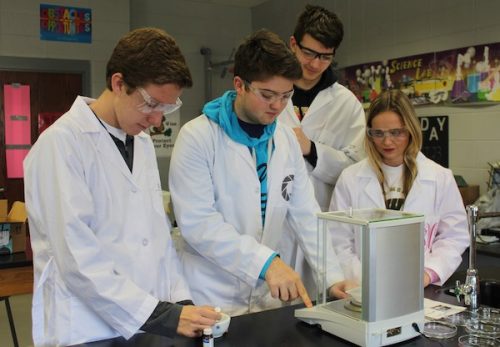
SSEP students precisely measuring the amount of iodine tablet for their Water Purification experiment in microgravity.
Proposal Summary:
The recent discovery of water on Mars has opened a possibility of new ways that the life sustaining liquid can be obtained in space travel. This new method would rely on collecting water from space bodies that are not our own. The only problem with this method is determining if this water would be safe to drink. Our team is proposing to study if microgravity has any effect on the purification of water. We would collect water from a non-sterile source, like a pond and mix it with purification tablets. Next, we would test the water to see if anything harmful survived.
HONORABLE MENTION FINALISTS:
Can Aquatic Canna Seeds Germinate in Space?
Grade 7, Winfield Middle School, Winfield City Schools
Principal Investigator: Kaitlynn Lynn
Co-Investigators: Jeremiah Conner, Daisy Franks, Kylie Long, Alex Neels
Teacher Facilitator: Freda Curd
Proposal Summary:
Our experiment is about the germination of canna seeds in space. We think this would be a really good experiment to do because canna has many good purposes for humans and nature. For example, Zingiberales (aquatic canna) can cleanse dirty water and make it drinkable. How our experiment can be very useful is when we go on the Mars spaceflight, canna could cleanse the dirty water so that the astronauts can recycle their water and they will not run out. The astronauts can also bring less water which can be helpful for their spaceflight. Plus, it can reduce the weight of the spacecraft, this could be very helpful because it would reduce the risk of the spacecraft being overloaded. Also, recycling water with canna can be very helpful on Earth. This can be helpful on Earth because we clean water with chemicals and that can be dangerous. If we use canna then it would be a lot safer; plus we could clean our water at home. This would save money for chemicals and it would save all of the work people have to do to clean water, maybe even save money on people’s water bills. So, when the astronauts go to Mars or any other planets they can just use canna to purify their water. Canna is a very light-weight plant so it would not be an issue to take it along for any space flight.
Will Honey Bees Larvae Successfully Grow in Microgravity?
Grade 6, Winfield Middle School, Winfield City Schools
Co-Principal Investigators: Charlee Kate Aldridge, Thomas Braxton Cunningham, Gracen Rooker Guin, Kennah Beth Lacy, Mason Rylie Aldridge Miller, Everett Bravell Tilley IV
Teacher Facilitator: Ashley Seals
Proposal Summary:
Our experiment will be based on honey bees. Our experiment’s question is the following: Will honey bees’ larvae successfully grow in microgravity? Our hypothesis is that honey bee larvae will successfully hatch and grow in microgravity. The species of honey bee that we are using is the Western honey bee (Apis mellifera). It takes approximately 24 days for the bee to start its process of becoming a bee. We are going to send the eggs to NanoRacks, and on the way they will mature to larvae. By the time they get to the International Space Station, they will become larvae. The reason we decided to do this is because honey bees are becoming a global concern. Dying bee hives are an issue and a huge risk to the pollination cycle. If bees successfully hatch faster in microgravity that will clear the concern. This will clear the global concern because if bee hives grow in microgravity and if the astronauts bring them back, or maybe even keep them up in space, there would be no concern of them dying out of our ecosystem. Honey bees are very important in the every-day lifecycle. They heel all cut or open wounds and they help with diabetes. The honey is used for natural flavoring in a lot of food items. Honey bees are a huge help to the pollination cycle. Honey bees need plants and plants need honey bees and that’s why we would greatly enjoy the ability of being able to start colonies on Mars.
5. Corcoran, California
Jump to Corcoran’s Community Profile
SELECTED FOR FLIGHT:
The Brine Shrimp Study
Grade 7, John Muir Middle School, Corcoran Unified School District
Co-Principal Investigators: Luz Angelica Medina, Anneliese Trevino
Co-Investigators: Carolina Leal Aceves, Rozalynn Yang-Garza
Collaborator: Mariana Moreno
Co-Teacher Facilitators: Jonathan Sorrick and Jari Stokes
Proposal Summary:
In this proposed study, we will be experimenting with Brine shrimp eggs in microgravity. We will send dried Brine shrimp eggs into space to observe and study their hatching and maturation rate. We have found throughout our research that Brine shrimp are very similar to Krill. Krill produces a powerful antioxidant called astaxanthin; that helps avoid spoiling in your stomach. Krill oil also contains EPA and DHA, which helps the body absorb Omega 3. Omega 3 has multiple health benefits such as helping with blood fat, Rheumatoid Arthritis, stiffness in joints, depression, ADHD, Alzheimer’s disease, and dementia. Due to Krills´ size, it would not be able to fit into the FME tube. Instead of sending Krill to space, we will be using Brine shrimp as a test subject. Brine shrimp can also possibly be the food source for other aboard animals. According to an article we found, it states that brine shrimp can be a food source for other sea predators or any other animal that can consume brine shrimp. The exact steps are: 1: compress gas glass cleaner into FME tube, 2: Put in the 1st plug, 3: Place 0.0002 oz Brine shrimp eggs in the tube, 4: Add 1 ml of yeast into the tube, 5: Snap on clamp A, 6: Pour in the 6.3 ml of our saltwater mixture, 7: Snap on clamp B, 8: Pour in 1 ml of Formalin, 9: Put in the 2nd plug. After the necessary steps are conducted, the mini labs will be ready for data observations. As soon as the experiment arrives back to Earth, we will analyze the results, comparing the two mini labs. Without this experiment going to space, our questions are not put to rest.
HONORABLE MENTION FINALISTS:
Aloe Vera Space Plant Study
Grade 6, John Muir Middle School, Corcoran Unified School District
Co-Principal Investigators: Karen Mendoza-Alvarez, Alaina Solario
Investigator: Aaliyah Nevarez
Teacher Facilitator: Alexandria Dias
Proposal Summary:
Our SSEP experiment is to send aloe vera seeds from MySeeds.Company, Arrowhead Spring Water from Walmart, isopropyl alcohol from Walmart, and potting soil from Walmart. Some reasons for this experiment is if an astronaut gets an injury the aloe vera will stop the injury from getting an infection. Aloe vera is a food source, so if it grows fast in space then it can be eaten. Aloe vera is healthy because it contains the vitamins A, C, E, B1, B2, B3, B6, and vitamin B12. The experiment contains potting soil, aloe vera seeds, Arrowhead Spring Water, and 91% isopropyl alcohol. We will use the type 3 FME. Step 1: 1 milliliter of potting soil, and 4-6 aloe vera seeds in volume 1. Step 2: 3 milliliters Arrowhead Spring Water in volume 2. Step 3: 4 milliliters of 91% isopropyl alcohol in volume 3. While our seeds are germinating in space, we will have seeds growing here on Earth.
Gummy Bear Osmosis
Grade 6, John Muir Middle School, Corcoran Unified School District
Principal Investigator: Guadalupe Garcia
Teacher Facilitator: Kenia Arreguin
Proposal Summary:
My project revolves around osmosis, which is a process by which molecules of a solvent tend to pass through a semipermeable membrane from a less concentrated solution into a more concentrated one. So this is how one mass is absorbed into another mass that only lets in, in this case, water to be absorbed. This project consists of observing a gummy bear and water to see how the gummy absorbs the water. I want to see how microgravity affects osmosis of the gummy bear. I want to see how much mass the gummy bear gets after it is exposed to the water. The FME that I would be using in my project would be a type 3 FME.
6. La Verne, California
Jump to La Verne’s Community Profile
SELECTED FOR FLIGHT:
Flammulina velutipes Growth in Microgravity
Grades 11-12, Damien High School, Archdiocese of Los Angeles
Co-Principal Investigators: Anthony Ebiner, Curtis Lin, Dylan Mckenzie, Kotoi Wu
Teacher Facilitator: Charity Maricic
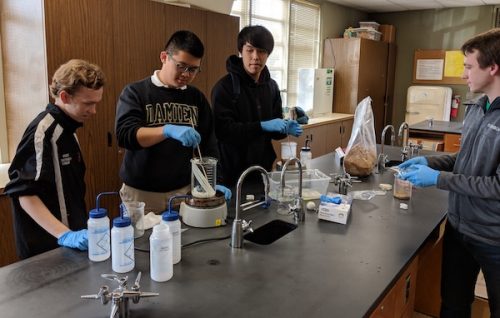
Damien students sterilizing equipment and setting up a trial run of their experiment to see how mushrooms grow in microgravity. Pictured from left to right are: Anthony Ebiner, Curtis Lin, Yifeng(Kotoi) Wu, Dylan McKenzie
Proposal Summary:
The experiment being proposed is studying the effect of microgravity on fungi growth patterns. The two main objectives of this experiment will be to see how these observed growth patterns can help in the propagation and cultivation of mushrooms in space and to see if the results will prove or disprove two theories on how fungi can detect gravity: 1. David Moore’s theory on mushroom gravimorphogenesis: the apex of the stem is the part of the organism that sensitively responds to gravity’s effets and 2. Jan Monzer’s theory on fungi gravitropism: the nucleus of fungi’s hyphal cells act like an otolith, responding to the direction of the gravitational forces. Each theory defines an independent set of detection systems. Monzer’s theory defines the system by which the fungi detects gravity while Moore’s defines the system by which the fungi reorients itself. By finding out which one, or both, is controlling the growth of the fungi, future experiments on the fungi will be able to better understand the optimum conditions in which to grow fungi. These theories will be tested by growing Enokitake mushrooms both aboard the ISS and on the ground as a control. The growth patterns of the samples will be studied and either Monzer’s theory, Moore’s theory, neither, or both will be confirmed. The most likely scenario is that both theories will be correct and thus allow a complete law of mushroom microtropism and gravimorphogenesis be established under Moores’ and Monzer’s names.
HONORABLE MENTION FINALISTS:
Effect of Microgravity on the Ability of Rhizobia Strains to Enhance Lentil Seed Sprouting
Grade 11, Damien High School, Archdiocese of Los Angeles
Co-Principal Investigators: Avishka Silva, Logan Joseph, Issac Magallanes, Kyle Martinich, Liam McNair
Teacher Facilitator: Charity Maricic
Proposal Summary:
Finding ways to optimize plant growth in space is an essential step towards expanding the duration of manned space exploration. Plants can support space travel through food and oxygen production and the reduction of carbon dioxide levels (Zabel 2016). If sustained plant growth can be achieved in space, the amount of food and oxygen that has to be transported from Earth can be reduced. While the International Space Station presently has the capability to grow plants, the limited amount of grow space makes it essential that plants that are grown produce high yields of nutritious crops. One crop that has significant nutritional value is the legume lentil (Lens culinaris). Lentils are an excellent source of essential nutrients, including prebiotic carbohydrates, proteins, folates, and minerals (Migliozzi 2015). It is now considered a superfood with multiple benefits to the human cardiovascular, immune and gastrointestinal systems (Ganesan 2017). However, it has been difficult to cultivate lentils in space (Zabel 2016). This may have been because the soil the plants were grown in space lacked appropriate bacteria. The symbiotic bacteria known as Rhizobia colonize the legume’s roots and provide beneficial effects that promote plant growth. Recent agrotechnological research has identified novel strains of Rhizobia that promote lentil growth. This experiment addresses whether inoculating the soil that lentils are grown in with specific Rhizobial species enhances the sprouting of lentil seeds in microgravity. If lentil seeds do exhibit enhanced sprouting, this method may become useful to grow this nutritious crop in space.
Development of Protein Crystals in Microgravity
Grade 11, Damien High School, Archdiocese of Los Angeles
Principal Investigator: John “Jack” Campbell
Co-Investigators: Joshua Berkessel, Benjamin Canty, Anthony Kolios
Teacher Facilitator: Charity Maricic
Proposal Summary:
The focus of this proposal is to differentiate the differences between the formation of protein crystals in microgravity and on Earth. It is important to experiment with the formation of protein crystals on Earth, where gravitational pull and rotational forces occur, and in microgravity to see how it affects the size and shapes. It is important to explore the different formations of the crystals because the results can differ and result in new discoveries that can lead to the development of new medicines. We are able to determine the shape of a protein through protein crystallization. The protein crystal that is being tested in the proposal is called Lactose Monohydrate. It is one of the active ingredients in one of the most popularly used influenza drugs. In order to form the protein crystals in microgravity, we will be combining distilled water and lactose monohydrate. At first, the two liquids will be separated by a clamp, then when it arrives it will be shaken gently several times on its trip to ensure that the two solutions are being completely combined. In all, the hope is with the final results, it will help further research in pharmaceutical studies.
7. Moreno Valley, California
Jump to Moreno Valley’s Community Profile
SELECTED FOR FLIGHT:
The Growth and Development of Sustainable Brine Shrimp in Microgravity
Grade 7, Palm Middle School, Moreno Valley Unified School District
Principal Investigator: Aidan Alvarez
Co-Investigators: Dorian Arias, Vince Mora
Collaborator: Vincent Ruiz, Andre Portlock
Teacher Facilitator: Gayle DiCarlantonio
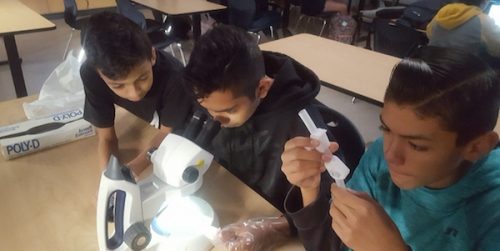
7th grader Aidan Alvarez examines brine shrimp in an FME mini-lab using a dissecting microscope with Vince Mora and Vincent Ruiz. Not pictured: Dorian Arias and Andre Portlock
Proposal Summary:
Our project will examine the response to microgravity of brine shrimp and possibly contribute to the further use of these animals as a resource in a food chain for raising fish on the International Space Station or another planet. Our goal is to do what we can to make sure that our experiment is successful and can be used to further research in this area. We believe that the shrimp may show a response to microgravity perhaps in their physical appearance or their rate of development. We will examine how the brine shrimp hatch and develop while in microgravity compared to on Earth. Both experiments will be done the same way including the time span, procedure, feeding, and fixation using 10% buffered formalin to preserve them. Also, we will ask the following questions as we analyze both brine shrimp populations: Are there any differences in the percent of shrimp hatched, their appearance, and in the types of developmental stages or the percent of shrimp at these stages? How can our findings contribute to using these animals as part of a marine aquaculture in microgravity?
HONORABLE MENTION FINALISTS:
How Does Microgravity Affect the Growth of Epsom Salt Crystals in Space?
Grade 7, Mountain View Middle School, Moreno Valley Unified School District
Co-Principal Investigators: Aithy Ho, Mia Ortiz, Yaritzel Rios-Aguilar, Rahil Tahir
Teacher Facilitator: Leslie Hetrick
Proposal Summary:
Our question for our experiment is “How does microgravity affect the growth of epsom salt crystals in space?” The reason of the proposed experiment is to find further information on the molecular structures that may be affected by the factor of microgravity. This experiment is important to the future where the scientists are trying to adjust to the lack of gravity in space and molecular structure would be one of the important subjects that would be in effect of many things.
Germination of German Chamomile in Microgravity
Grades 10-12, Canyon Springs High School, Moreno Valley Unified School District
Co-Principal Investigators: Melody Arteaga, Abigail Gutierrez
Co-Investigators: Darren Alain Manalo, Jocelyn Quiroz
Collaborator: Kira Shimamura
Co-Teacher Facilitators: Divina Elbo and Sharon Scott
Proposal Summary:
Astronauts face many physical challenges to their well-being while in space including osteoporosis, gastrointestinal disorders, and skin problems (infections, itchy, and dry skin). In addition, female astronauts have to endure menstrual pain in microgravity. German chamomile can help relieve all of these problems, due to the medicinal benefits of the plant. The experiment will investigate the germination process of German chamomile in microgravity. Contained in the FME tube will be four German chamomile seeds, soil mixed with water, and a 10% Neutral Buffered Formalin solution. The FME tube will be sent aboard the International Space Station (ISS) to conduct the experiment in microgravity. The chamomile seeds will then be mixed in moist soil on the second crew interaction day. After the seeds have been planted for twenty days, formalin will be added to the soil to preserve the integrity of the plant. On Earth, a similar experiment will be conducted. Once the FME tube is returned to Earth, the length of the plants’ roots will be measured and compared to the roots of the plants germinated on Earth. If the roots from the FME mini-lab turn out to be the same length or longer than the roots from the experiment conducted on Earth then it can be concluded that chamomile can be grown in space. If the roots are not the same length or longer than the roots of the plant from Earth, then it will be concluded that microgravity does have an effect on the germination process.
8. North Hollywood, California
Jump to North Hollywood’s Community Profile
SELECTED FOR FLIGHT:
The Effects of Microgravity on Cell Recognition
Grades 10-11, Oakwood School
Co-Principal Investigators: Monie Choi, David Storm
Teacher Facilitator: Andrew Miller
Proposal Summary:
We propose to answer the question: How effective are pathogen associated molecular patterns in microgravity? We are measuring protein recognition receptors ability to signal immune responses in the presence of an Escherichia coli infection while under the influence of microgravity and comparing their functionality to similar receptors on Earth. The purpose of this experiment is to see if cell recognition is less efficient in space than in a gravitational setting. It was predicted that with the seemingly endless increased interest in space travel, there have been multitudinous investigations conducted studying the effects of microgravity on the immune system. Results from many of these studies concluding that the immune system is severely weakened by microgravity (Graham, 2018). Cell recognition plays a crucial role in the effectiveness of the immune system as the body’s immune response is stimulated after recognizing specific antigens on the surfaces of pathogens (Marshall, 2017). Our experiment aims to investigate a possible reason as to why the functions of the immune system vary in an environment subjected to microgravity. We hope that the results from this investigation will be cause for increased scientific questioning in the biomedical world about protein recognition receptors and open new doors to treat unique diseases that are caused by faults in their capabilities. Alternatively, we hope to pinpoint the cause of weakening immune systems in microgravity to inch closer to the future of prolonged space explorations.
HONORABLE MENTION FINALISTS:
The Corrosion of 2219-T6 Aluminum Alloy in Microgravity
Grade 8, Oakwood School
Co-Principal Investigators: Avalon Bookstaver, Theo Burstyn-Paul, Trainor Kinloch, Moric Schonfeld
Teacher Facilitator: Kari Bosworth
Proposal Summary:
Our research question is how does 2219-T6 aluminum alloy corrode in microgravity when faced with a corrosive solution that consists of 45% vinegar, 45% bleach, and 10% sodium chloride? This specific type of aluminum alloy is the main type of metal used on the ISS. It’s specifically used in keeping the climate, oxygen, and other valuable things in the ISS, and protection from harmful radiation leaking into the spacecraft. If this metal ever corrodes on the ISS it could leave the spacecraft in a majorly drastic situation. Since salt water was found on Mars, this would be important for any future missions to Mars. It could also be devastating if something were to corrode on a development on Mars during a human mission to Mars. The knowledge to be gained is how the 2219-T6 aluminum alloy will corrode in microgravity. Based on the knowledge of chemical reaction moving faster in microgravity, and how the corrosion of aluminum is a chemical reaction, we hypothesize that the corrosion will happen more rapidly causing a greater amount of corrosion. Our dependent variable will be the weight of the 2219-T6 aluminum alloy, which will prove how much of it corroded.
Can Cytokinin be Distributed Throughout Arabidopsis thaliana with an Overexpression Line of AtABCG14 that are Grown Hydroponically in Microgravity?
Grade 8, Oakwood School
Co-Principal Investigators: Avalon Bookstaver, Theo Burstyn-Paul, Trainor Kinloch, Moric Schonfeld
Teacher Facilitator: Andrew Miller
Proposal Summary:
The next great frontier for humankind is going into space. The exploration of space comes with a plethora of problems, such as the production of food. Due to microgravity, cell growth and cell proliferation are uncoupled. Under normal circumstances the hormone cytokinin would be circulating throughout the plant along with its partner hormone auxin, but in microgravity cytokinin is not transported normally and stays in the roots unlike auxin, which is transported normally in microgravity. The goal of our experiment is to see if cytokinin will be distributed throughout arabidopsis thaliana with an overexpression line of AtABCG14 that are grown hydroponically in microgravity. There will be no difference when growing it since AtABCG14 helps out in transporting cytokinin in translocation. For our experiment we are going to use arabidopsis thaliana because it has a fast germination time. We are going to use FME mini lab type 3. In the first compartment we are going to have 4 arabidopsis thaliana seeds. In the second compartment we will have a water and nutrient solution. In the third compartment we are going to have salt water, which will be our fixative, and our dependent variable is the level of cytokinin in leaves, which we will measure via liquid chromatography tandem mass spectrometry. By doing this, we hope to find a way to help solve the problem of growing plants in space which is one of the first steps needed for space travel.
9. Riverside, California
Jump to Riverside’s Community Profile
SELECTED FOR FLIGHT:
The Effects of Microgravity on Saturated Copper Sulfate Crystals
Grades 4-5, John F. Kennedy Elementary School, Riverside Unified School District
Co-Principal Investigators: Ranteg Bajwa, Aiden Grover
Co-Investigator: Ivan Hughes
Collaborators: Olivia Guastella, Loc Andre Olea, Cheri Thompson
Teacher Facilitator: Carla Yawney
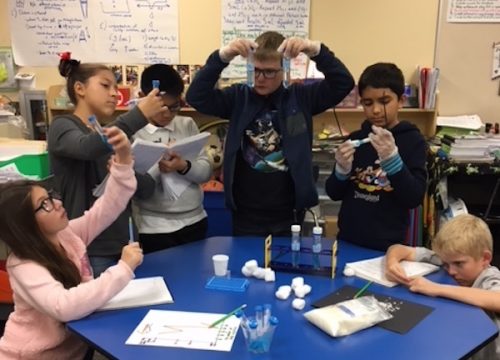
The young research team at John F. Kennedy Elementary school selected to conduct a microgravity experiment on saturated copper sulfate crystals aboard ISS.
Proposal Summary:
The purpose of our experiment is to find the effect of microgravity on the growth and structure of saturated Copper Sulfate crystals. We are examining whether these crystals will grow differently in microgravity than on Earth. We are proposing that microgravity can make the Copper Sulfate crystals grow extra slowly and therefore the crystals will have minimized flaws. In our experiment, we will be comparing the speed of growth and the structure of crystals in gravity and microgravity by observing the optical clarity, color distributions, and the crystal surfaces. Our hypothesis is that the crystals in the microgravity environment will be smaller, will have less flaws, and may grow somewhat slowly. This is because we think that the crystal will not settle to the bottom of the tube because it will float in the solution due to microgravity. This could be a better way to grow crystals for many uses, for example for new medical applications such as improving radiation detection for medical imaging, helping to make antidotes for nerve agents, and other technology and agricultural uses. The experiment includes Copper Sulfate, Ethanol, filtered purified Superhydrophobic foam, filtered purified water, and jelly crystals.
Effects of Microgravity on Radish Seed Germination
Grade 7, STEM Academy, Riverside Unified School District
Co-Principal Investigators: Adani Ahmad, Aliyah Zuwayed
Teacher Facilitator: Megan Harns
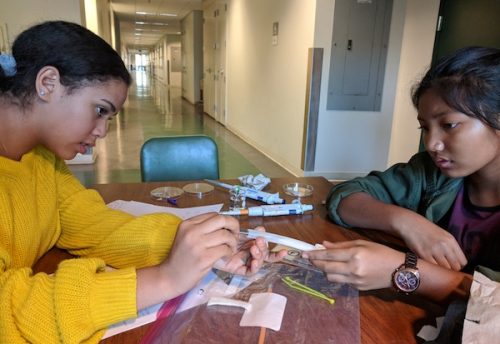
Riverside STEM Academy students working on their flight experiment to assess the effects of microgravity on radish seed germination.
Proposal Summary:
We propose to answer this question: Will radish seed germination be affected by microgravity? Last year we conducted an experiment in which different colors of light were used to test the effect on the germination of bean sprouts, so this new experiment will help further our research about the germination of seeds. We found out that on Earth, the roots of a seed start to grow downwards because of gravity, but seeds in space will be in microgravity, so they may sprout differently. We are looking for a radicle (baby root) to show that the seeds sprouted. Research based off two previous experiments gives evidence that there wasn’t a dramatic difference in germination between Earth and microgravity seeds (Briarty, 2004; Millar, 2011). However, these tests were on Arabidopsis thaliana seeds. We propose to use radish seeds, or Raphanus raphanistrum subsp. sativus, which take about three to four days to start to germinate depending on the conditions. This will be effective seeing as the experiment will be carried out for only 12 days. Our experiment will consist of two of the Type 3 FME Mini-Labs, whereas one test tube will be on ISS, and the other here on Earth. This way, we can compare the seeds in each tube once the ISS tube is returned to Earth. We hypothesize that the resulting amount of germinated seeds on ISS will be greater than the number of germinated seeds on Earth because microgravity will put fewer constraints on seed growth.
Chenopodium quinoa Cell Development in Microgravity
Grades 11-12, John W. North High School, Riverside Unified School District
Co-Principal Investigators: Karen Cortina, Audrey Cui, Alejandra Robles, James Rohde, Hannah Terao
Teacher Facilitator: Adam Quaal
Proposal Summary:
We are attempting to answer the question: How does microgravity affect the cell development of Chenopodium quinoa (C. quinoa) sprouts? Studies of C. quinoa development in microgravity may indicate whether the organism could provide a valuable food source for a long-term duration in space. C. quinoa contains a desirable combination of amino acids and secondary metabolites that can typically be achieved only through a blend of multiple food sources. Physiological characteristics of the plant, such as cell size, chloroplast count, cell wall dimensions, and overall sprout size are indicative of a plant’s current metabolism and stress resistance. We hypothesize that in a microgravity environment, the C. quinoa cells will grow larger than on Earth, with a greater number of chloroplasts and a thinner cell wall, because they will be exposed to a gravitational acceleration that is less than that on Earth. To test this hypothesis, we will send C. quinoa seeds up onto the International Space Station (ISS) and activate the seed germination with water. Once the C. quinoa seeds have sprouted, we will fixate the C. quinoa and its cellular structures using a formaldehyde buffer and examine them back on Earth to determine any changes in sprout size, cell size, chloroplast count, and cell wall thickness, as compared to a parallel experiment set on Earth. If this experiment is selected, astronauts and biologists will gain a valuable understanding of agricultural cultivation and may allow access to fresh nutritious food in long-term space exploration.
HONORABLE MENTION FINALISTS:
The Effects of Decalcification on a Tooth in Coca-Cola on Earth Versus in Microgravity
Grades 5-6, Castle View Elementary School, Riverside Unified School District
Co-Principal Investigators: Mackenzie Ankeney, Sydney Crowder, Madeline Waddell, Presleigh Williams
Teacher Facilitator: Michelle Roeder
Proposal Summary:
This experiment aims to discover if there is a difference in the decalcification of teeth. The way the team will determine if there is a difference is by placing an extracted tooth in the mini-lab along with Coca-Cola and sending it to the ISS in microgravity while conducting the same experiment here on Earth. Upon return of the tooth sample from the ISS, and with the help of our dental hygienist advisor, we will examine both samples and determine if there is a significant difference in the amount of decalcification or manner of decalcification of both teeth. This is an important study to be conducted as it concerns astronaut health as the rate or manner of decalcification of teeth in microgravity may be different than with Earth’s gravity.
Is Bifido Bacterium as Effective Against E. coli in Microgravity than on Earth?
Grade 6, Riverside STEM Academy, Riverside Unified School District
Principal Investigator: Kate Reznick
Teacher Facilitator: Megan Harns
Proposal Summary:
I think it is important to find out if Bifido bacteria is not as effective on E. coli when both are exposed to microgravity because if people on the ISS took Bifido bacteria as a probiotic to prevent an E. coli infection and the Bifido bacteria does not work then the infected person could infect the ISS and the astronauts do not have access to professional medical help so this experiment is to stop astronauts from getting infected with E. coli. My hypothesis is that when Bifido bacteria is exposed to microgravity, it will not be as effective as a probiotic against E. coli compared to how useful Bifido bacteria against E. coli is on Earth. I am doing this experiment because I am interested in the immune system. When I was researching that I saw that the immune system was weakened after long periods of time in space and since probiotics are for the immune system I wondered if they were weakened after long periods of time in space.
Salt Crystal
Grades 7-8, Central Middle School, Riverside Unified School District
Co-Principal Investigators: Isabelle Anderson, Vincent Garavito, Shelby Morat, Karol Rivera
Teacher Facilitator: Monica Taylor
Proposal Summary:
A salt crystal is a hygroscopic material, and can collect water from the air around it. The experiment will be a type 2 FME mini lab. The two substances in the experiment will be tap water and table salt. It will take, at most, a week for the crystals to start to grow, once the experiment has begun. The experiment itself will be growing two salt crystals in different types of gravity. One will be in a microgravity environment, and the other will be within Earth’s gravity. We want to know if the microgravity environment will affect the crystal’s growth.
The Transition of Glucoraphanin to Sulforaphane in a Microgravity Environment
Grade 8, Matthew Gage Middle School, Riverside Unified School District
Co-Principal Investigators: Jose Anaya, Alexa Cargando, William Cloake, Bryan Sibbett, Michael Spencer
Teacher Facilitator: Elizabeth F. Marroquin
Proposal Summary:
Sulforaphane is a compound that can be found in cruciferous vegetables. Numerous studies have shown that sulforaphane disables the protein myostatin. Myostatin is a protein that regulates muscle growth and inhibits skeletal muscle regeneration. This means that sulforaphane can help us preserve and gain more muscle. In this mission, we want to find out if the chemical reaction between the enzymes and myrosinase, and glucoraphanin successfully turns glucosinolates into sulforaphane in a microgravity environment. By doing this, we can have the possibility of maintaining muscle mass in space using sulforaphane. We want to focus on this study for humans who can lose up to 20% of their muscle mass in the span of 5 days when in a microgravity environment. If we can counteract or at least reduce the loss of muscle mass by reducing myostatin using sulforaphane, it can be greatly beneficial to astronauts who need to go on long journeys, for sulforaphane can be easily found in vegetables like broccoli or cauliflower.
Effects of Microgravity on Oxidative Stress in Caenorhabditis elegans
Grade 12, John W. North High School, Riverside Unified School District
Co-Principal Investigators: Dianara Abarca, Kimberly Stahovich
Collaborator: Anna Reck
Teacher Facilitator: Adam Quaal
Proposal Summary:
Oxidative stress is a metabolic cellular process in living organisms that occurs when there is an imbalance between oxidants and antioxidants. The concentration of oxidants can be increased through environmental stressors. Potential adverse effects from oxidative stress include diabetes, atherosclerosis, cancer, hypertension, and osteoporosis, among other diseases and pathological conditions. Because prior research suggests that Caenorhabditis elegans (C. elegans) exhibits oxidative stress in simulated microgravity, we propose here to use them as a model organism to quantify oxidative stress caused by the microgravity environment aboard the International Space Station (ISS). The gst-4 gene is a marker in C. elegans of oxidative stress and we will use a strain of C. elegans (CL2166) that has the gst-4 gene tagged with Green Fluorescent Protein (GFP). A sample of C. Elegans will be put into a dormant state (dauer larvae) and then they will be activated in space by exposing them to E. coli OP50, their food source, five days before undocking. After three days (two days before undocking) the specimens will be fixed with ethanol to stop further activation of the gst-4 gene. A control sample on Earth will be treated in the same way, except that Earth’s gravity will be in effect. When the FME is returned to Earth, the fluorescence of the gst-4 will be quantified using a fluorescent microscope. The level of fluorescence of the microgravity sample will be compared to that of the ground control to contrast the oxidative stress responses.
10. Ashford/Willington, Connecticut
Jump to Ashford/Willington’s Community Profile
SELECTED FOR FLIGHT:
How Microgravity Effects Beetroot Seed Germination
Grades 6 and 8, Ashford School and Hall Memorial Middle School, Ashford School District
Co-Principal Investigators: Alison Bean, Anna Dietz, Skylar Garrison, Parker Perosky
Co-Investigators: Adam Dunham, Thaddeus Kelly
Teacher Facilitator: Dory Moore
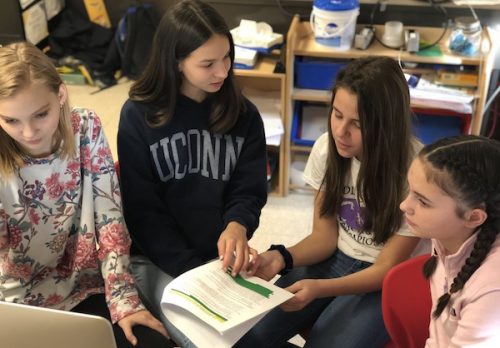
Ashford-Willington students work to finalize their proposal for their project, “Growing Beetroot Seeds in Space”.
Proposal Summary:
We are proposing to study the effect of fertilizer on a beetroot seeds from Hart Seed Supply in a microgravity environment and compare to a seed growing with the same fertilizer on Earth. Specifically, we chose beetroot seed due to its health benefits such as lowering blood pressure, improving memory and helping muscles when you exercise. Beetroot helps your blood pressure do down, it also helps people with diabetes and contains high levels of fiber. This experiment is important because we would be able to find a new way to provide faster growing and nutritious food for astronauts. Having the plant in a microgravity environment could also help us discover an innovative process to grow abundant plants for those on Earth. If it appears that microgravity has a positive effect on plants, we would be able to not only provide food for astronauts, but also average people and animals as well. For example, if in the future we face a world hunger crisis, we could grow nutritious produce in space when expansion in technology and infrastructure has not left room for growing plants and crops.
HONORABLE MENTION FINALISTS:
Bacteria in Microgravity
Grades 6-7, Ashford School and Hall Memorial Middle School, Ashford School District
Co-Principal Investigators: Mya Abbott-Phipps, Daniel Grady, Nathan Johnson, Arya Patel, Brent Robbins
Co-Investigators: Isaac Vazquez, Jameson Courtois
Teacher Facilitator: Dory Moore
Proposal Summary:
Our question is what is the difference between bacteria growth on Earth compared to microgravity. To figure this out our idea is to take a vile that has a clamp in between that separates plain yogurt that contains unpasteurized milk and bacteriostatic water up to the ISS. The reason we are using unpasteurized milk is that it could possibly have a type of deadly bacteria called listeria, but, it is not guaranteed to be in it. We also know that listeria is one of the only types of bacteria that can survive in space. The reason for using bacteriostatic water mixed with yogurt is because, according to medicalnewstoday.com, bacteriostatic stops bacteria from multiplying. As we already established that bacteriostatic can come in the form of water. So, if we mix bacteriostatic water and bacteria, the water will stop the bacteria from multiplying. Right? On top of that, we also know that bacteria multiplies when it is exposed to warmth, moisture, and nutrients. So, if we mix bacteriostatic water that has a lot of moisture and yogurt then the bacteria in yogurt will start multiplying, then the bacteriostatic water will stop the bacteria from multiplying (only on Earth). So, we want to know, in microgravity, will the bacteriostatic water stops the bacteria from multiplying? How can we tell if the listeria has multiplied or not? Well, by using a microscope that has a magnification of 400x to 1000x.
The Effects of Sunflower Seeds in Microgravity
Grades 6 and 8, Ashford School and Hall Memorial Middle School, Ashford School District
Co-Principal Investigators: Kinsey Donegan, Faith Halloran, Gracie Martinez
Co-Investigators: Alexander Barr, Andrew (AJ) Bean
Teacher Facilitator: Dory Moore
Proposal Summary:
Our team is studying how microgravity affects sunflower seeds. If it affects the seeds in a positive way, this could benefit the astronauts in many ways. For one they will have a source of food, sunflower sprouts are extremely nutritional greens, and also produce seeds that are edible. These seeds are also easily plantable so you have a supply of food. These plants are also green. Which according to a study conducted by NASA in 2017, helps astronauts reduce the feeling of isolation. Sunflower sprouts are also a good supplement to their diets and they probably miss fresh, green food because they mostly eat frozen space food. We don’t know how the technology will affect the growth of the sunflower sprouts (positively or negatively) but we are willing to find out.
11. Hillsborough County, Florida
Jump to Hillsborough County’s Community Profile
SELECTED FOR FLIGHT:
Mung Bean Project 2018
Grades 6-7, Randall Middle School, Hillsborough County School District
Co-Principal Investigators: Riana Basista, Payton Hardy, Sydney Jacobson, Alexander Januario
Teacher Facilitator: Mary Vaughn
Proposal Summary:
Mung Beans will allow an advancement in space travel by providing a food source that will keep astronauts healthy on long term space mission. They are full of nutrients and are simple to grow. The Mung Beans are sourced from Sprouts grocery store. According to hunker.com, the germination period can be 4-5 days depending on the amount of water that is present during germination. Inside the volume 1 of the FME of the tube we have water for watering the Mung beans. The water is from our local water source at our school. In volume 2 we have the Mung beans and felt, which is going to act as a medium for the beans to root into. In volume 3 of the FME there is formalin. Formalin is a fixative and will be used to stop the growth of the Mung Beans. Through experimentation with the pilot tests we have determined to put 5 Mung Beans in the FME. If we could grow Mung Beans astronauts would have a great food source, since Mung Beans contain plenty of nutrients like vitamins K, B2, B9, B5, B6, C, and B1 thiamine. They can keep astronauts healthy on long flights to other planets such as Mars. Mung Beans can also be eaten raw, which means there will not be a need to send extra supplies to prepare the Mung Beans. Mung Beans would help astronauts stay healthy since they’re great at fighting heart disease, cancer, and diabetes.
HONORABLE MENTION FINALISTS:
Spinach on Station
Grades 6-7, Randall Middle School, Hillsborough County School District
Co-Principal Investigators: Charles Edge, Grace Kalnins, Lucas Mcmillin
Teacher Facilitator: Mary Vaughn
Proposal Summary:
Spinach is a source of many vitamins and minerals. The vitamins and minerals give spinach the ability to help humans fight off medical problems. Spinacia oleracea also has the ability to germinate quickly which is very important because it would be able to germinate quickly on long term missions. Spinach is healthy and is a great choice to send up to the ISS. Because of its ability to germinate quickly spinach would be able to germinate not long after it reaches the station so the experiment could be started soon. The amount of vitamins and minerals it contains could allow astronauts to get the nutrients they need in space. The vitamins and minerals spinach has can help with several medical problems. For example the website “10 Foods to Eat everyday for the Perfect Skin, Kcal life” states that vitamins A, C and E are especially great for your skin. Vitamins A, C and E are all found in spinach. Salad Sensation Hybrid spinach doesn’t just have vitamins A, C and E it also has the plant compound lutein which helps improve eye health. We already know that astronauts are eating spinach on the ISS however it is dehydrated therefore it loses most of its nutritional value which is why we are seeing if spinach can grow in microgravity. In conclusion we are sending spinach to the ISS because it will be able to germinate in the time frame, be able to help medically, and because of all of its nutrients.
How Do Onion Seeds Germinate in Space
Grade 7, Randall Middle School, Hillsborough County School District
Co-Principal Investigators: Nigel Antoine, Jonah Beckman, Tyler Hobbs
Teacher Facilitator: Mary Vaughn
Proposal Summary:
Onion seeds, a great snack for couch potatoes can go to space? The onion seed is very small, with a germination rate of 10-12 days, meaning they won’t cost much to send to space. Onion seeds contain 45 calories per serving, and have a hefty amount of Vitamin C and B6 compared to a shallot which is high in vitamin C and B6. Onions are an excellent source of iron, folate, and potassium compared to kale. Both onions and kale have similar amounts of nutrients. All of these nutrients can benefit the astronauts on the ISS. This is key to exploring places we couldn’t before, like Mars, or a different galaxy! In our trials we put the onion seeds in a clear plastic shoe box to observe them and to give them space to grow. They can withstand a minimum of 55 degrees F and max of 75 degrees F in the air and soil this has been tested in the classroom environment which is a steady 75 degrees F. A way to increase water infiltration is to use polyacrylamide. These could be future suggestions for growing onions on the station and for Mars missions. In conclusion, onion seeds can be very beneficial for the astronauts on the ISS. The health benefits of onions such as vitamins and a source of energy can help astronauts stay healthy. This can spark a new era in foods sent to the ISS.
12. Port St. Lucie, Florida
Jump to Port St. Lucie’s Community Profile
SELECTED FOR FLIGHT:
The Effects of Microgravity on the Germination of Culinary Lavender
Grade 8, Renaissance Charter School at Tradition, St. Lucie County Schools
Co-Principal Investigators: Jolina Jofors, Marcella Melo
Co-Investigators: Brooklyn Brandt, Deidra Gurin
Teacher Facilitator: Danielle Bisaccio
Proposal Summary:
The question that we are focusing on is how microgravity will affect the germination of culinary lavender. Lavender (Specifically Culinary Lavender) is commonly used for its convenience here on Earth. In fact, it can be put in pretty much anything. Lavender can be used in teas, essential oils, as a seasoning in food, or just for the aroma. Also lavender oil can help with anxiety or depression, which is a major struggle that astronauts deal with. We are seeking to discover what effect microgravity has on the germination of the lavender. We decided to use culinary lavender because this can be used for the astronauts. We believe that this will give us a greater understanding on how microgravity will affect germination of plants.
HONORABLE MENTION FINALISTS:
The Effects of a Microgravity Environment on the Growth of Kelp
Grade 5, Renaissance Charter School at Tradition, St. Lucie County Schools
Co-Principal Investigators: Layla Andres, Kathryn McDermott, Hunter Wilson, Autumn Wisecup
Teacher Facilitator: Jennifer Gordon
Proposal Summary:
We are choosing to send kelp (laminarial) into microgravity because of its many health benefits. Sea kelp is a natural source of vitamins A, B1, B2, C, D and E. All of these vitamins help keep us healthy; from immune and heart health, to reducing chronic illnesses. Kelp also has vital minerals including iodine, zinc, magnesium, iron, potassium, copper, and calcium. Kelp contains the highest natural concentration of calcium of any food; 10 times more than milk. We believe that if we can cultivate sea kelp in microgravity, then the astronauts will have a food supply with multiple health benefits.
The Reproduction of Desulfovibro Vulgaris
Grade 8, Renaissance Charter School at Tradition, St. Lucie County Schools
Co-Principal Investigators: Amari Foskin-Smikle, Alexis Hayes
Co-Investigators: Jordynn Le, Amanda Messina
Collaborator: Adriana Sommer
Teacher Facilitator: Danielle Bisaccio
Proposal Summary:
SRB is a bacterium that is most commonly found in a low oxygen environment like zinc mining tunnels and sometimes in our drinking water. SRB stands for sulfate reducing bacteria, Desulfovibrio vulgaris which is part of the Desulfobacteriaeceae family filters out water from harmful minerals like zinc, selenium, and arsenic. Our proposal is to send Desulfovibrio vulgaris to a microgravity environment to see if the reproduction rates increase. If the reproduction rates increase, we could take that bacteria and use it to filter out water in areas that are deprived of clean water. We plan to put a specimen in a tube and record the periodic growth and compare it to the growth on Earth.
13. Berea, Kentucky
Jump to Berea’s Community Profile
SELECTED FOR FLIGHT:
Rate of Rust Formation in Microgravity
Grade 11, Berea Community High School, Berea Independent School District
Principal Investigator: Michael Mecham
Co-Investigators: Lucas Hannon, Brent Robinson, Breanna Smith
Collaborators: Julia Kilgore, Carlyn Mcdonald
Teacher Facilitator: Christopher Preece
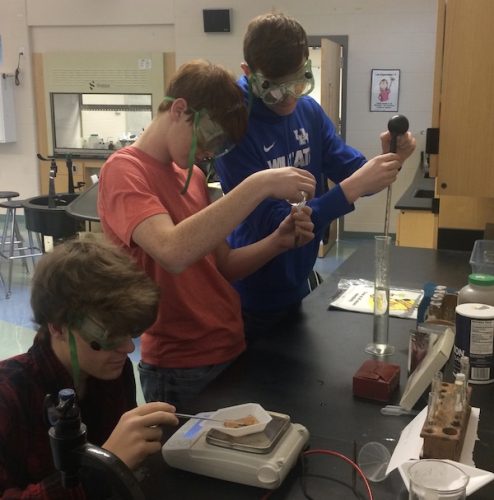
Lucas Hannon, Michael Mecham, and Brent Robinson (l to r) spent long hours perfecting a technique to quantify iron oxidation.
Proposal Summary:
Our group’s experiment is testing the question of what the rate of rust formation is in microgravity. This experiment could potentially be important to NASA because if microgravity does affect how quickly something rusts in space then knowing the data collected from our experiment could help in the development of future space equipment depending on the results. This experiment would only require 12 days and will also be done on Earth in a classroom setting simultaneously to compare rusting rates. The needed procedure for this experiment would be to have the tube consisting of 3 different chambers, salt water, steel nails, and sodium polyacrylate. You unclamp Clamp A between the Steel Nails and the salt water and let it sit for a period of 12 days. After 12 days you would unclamp Clamp B between the sodium polyacrylate and the salt water (The polyacrylate will soak up all of the salt water in the tube and stop it from continuing to rust). When the sample returns back to us, we will put isopropyl alcohol in the tube, loosening the sodium polyacrylate so the nails can be removed easily. After the nails are extracted from the sodium polyacrylate, the nails will be put into acetic acid for 3 days, removing any remaining rust and leaving only the steel. The rust particles removed from the acetic acid can then be taken and analyzed using a microscope, allowing us to see any differences there may be in the formation of the rust. Then the two samples will be weighed, and the difference in weight will determine which sample rusted more, as rust takes away from the mass of an object. You could then see the rate at which rust was able to form in microgravity and compare it to the rate it forms on Earth. The results of this experiment will allow us to see and gain data about how rust forms in a microgravity setting compared to how it forms on Earth.
HONORABLE MENTION FINALISTS:
Effects of Polyethylene Glycol 3350 on Monoclonal Antibody Crystallization Quality while in Microgravity
Grade 9, Berea Community High School, Berea Independent School District
Co-Principal Investigators: Luke Hayden Seals, Bidhu Sharma
Teacher Facilitator: Joshua Woodward
Proposal Summary:
Crystallized monoclonal antibodies are currently being researched as they are used to fight diseases including some types of cancer and can be gateways to potential cures for other human diseases. Previous research has shown that monoclonal antibodies crystallize at a much higher quality in microgravity than in terrestrial environments, which can make research on them much easier. Based on crystallization trials performed under gravity conditions, we speculate that the crystallization quality of monoclonal antibodies will be altered if mixed with different concentrations of polyethylene glycol 3350 (PEG 3350) whilst in the environment of microgravity. The way in which the PEG 3350 interacts with the antibody leads us to hypothesize that both concentrations of the precipitant will increase the crystallization quality of the antibodies, and that the greater concentration of precipitant will increase the quality more than the smaller concentration. The experiment will initiate on the ISS upon sequential mixing of three reaction compartments in a FME Mini-Lab apparatus, generating two reactions containing 11% or 22% PEG 3350 with antibody concentration remaining constant at 1 mg/ml. Using light microscopy, we will determine if the quality of the crystals changes with the precipitant, comparing the results with samples crystallized on Earth. We anticipate that these studies will contribute to future efforts to study monoclonal antibody structure and function using microgravity-based crystallization methods.
Planarian Regeneration in the Microgravity Environment on Board the ISS
Grade 9, Berea Community High School, Berea Independent School District
Co-Principal Investigators: Jason Combs, John Orr, Alex Wright
Teacher Facilitator: Christopher Preece
Proposal Summary:
For our experiment, we plan on sending Planarian worms, which reproduce asexually, into space and aboard the ISS for a test to see how and if their regeneration process is affected in any way. We will purchase a planarian worm and then proceed to cut it in half. One half will stay on Earth as a control while the other half is sent into space. We will chill the worm to slow the regenerative process to make the result of the regeneration in space more accurate. We will see what changes there are between the two halves of the worms at the end of the time period. After examining both halves we will come to a conclusion on how the microgravity affected the worm. This information is important because it will first and foremost, provide insight into how space affects the regeneration of asexual creatures. And this is important, as it could reveal a way to repopulate asexually reproducing creatures. For example, if the planarians were to return with no defects and were significantly bigger than the Earth counterparts, we would know that if population planarians was ever declining, they could be farmed on a space station, then sent back to Earth. It might even hypothetically apply to other asexual organisms like starfish for example.
14. Anne Arundel County, Maryland
Jump to Anne Arundel County’s Community Profile
SELECTED FOR FLIGHT:
Effect of Microgravity on the Structural Strength of Concrete
Grade 6, Magothy River Middle School, Anne Arundel County Public Schools
Co-Principal Investigators: Gabby Munoz, Ethan Shellem, Gavin Wildberger, Caleb Young
Teacher Facilitator: Lauren Ebersberger
Proposal Summary:
Our project title is “The Structural Integrity of Concrete in Microgravity.” We are testing if concrete can still hold it’s natural structural integrity in microgravity. Our definition of structural integrity is the ability of an item to hold together under a load without breaking or deforming. We are testing this to see if we could build on Mars or other neighboring planets and moons the same way we can on Earth. We found that concrete is made of 60% limestone, 25% silica, 5% alumina, iron oxide, and gypsum or Portland cement, pebbles, and sand. We believe that we will need a Type 2 Mini Lab, half filled with 3.2 grams of Quikrete powder and half filled with 1 mL of water. When we have both tubes of concrete back to us, we will have our teacher help us use a razor blade to remove the concrete to measure how much weight the concrete can hold to see if the concrete will have the same structural integrity when hardened in microgravity as it does when hardened on Earth. The main thing that our team will be testing is whether concrete hardened in microgravity can hold the same amount of force as concrete hardened on Earth. Without testing this, we would be unable to narrow down the list of building materials that could be used in microgravity.
HONORABLE MENTION FINALISTS:
How Does Microgravity Affect the Hatching and Development of Brine Shrimp?
Grade 6, Central Middle School, Anne Arundel County Public Schools
Co-Principal Investigators: Arianna Bodycomb, Adeline Burke, Nikita Mehta, Grace Solan
Teacher Facilitator: Cathrina Jade Spencer
Proposal Summary:
In the experiment, we will be observing brine shrimp in a microgravity environment throughout twelve days. The experiment will contain 10 brine shrimp eggs, 4 mL of water, 2 mL of neutral buffered formalin (preservative), 380 milligrams of API aquarium salt, 1 tablet of dissolved oxygen, 1 tablet of green algae, a microscope, a magnifying glass, and a milligram scale. The eggs, algae, water, salt, dissolved oxygen, and preservative will be in a closed environment with clamps separating them from each other. The astronauts on the ISS will help raise the brine shrimp from an egg until they must preserve them for the trip back to Earth. Then we will use the preservative to freeze them until they reach Earth for us to compare and contrast. The experiment is significant to NASA’s research because brine shrimp is a possible food source for bigger fish and bigger fish are a great food source for humans. This can create a miniature food chain. The experiment is the first step to aquaponics in space. Aquaponics can help us raise species of aquatic animals and cultivate plants in space for colonization on Mars. We hope that the experiment will help NASA with its journey throughout space and its mission to Mars.
How does Microgravity Impact the Germination of Dandelions?
Grade 6, Central Middle School, Anne Arundel County Public Schools
Co-Principal Investigators: John Bertuna, Connor Feldmann, Aidan Stock
Teacher Facilitator: Cathrina Jade Spencer
Proposal Summary:
Our experiment is to find out how microgravity impacts the germination time of dandelions. Why dandelions specifically? Well, dandelions can help relieve joint pain and muscle aches. They are also edible and are used in different types of salad. It has a fast germination time of 4 to 6 weeks, on Earth, and hopefully it will grow faster in microgravity. Joint pain and muscle aches are big problems for the astronauts aboard the International Space Station. (ISS.) If microgravity has no impact on the plant, then we can get one step closer to making our own medicine in space instead of spending large amounts of money shipping up resources. If we can get research on dandelions, then maybe we can find more information on other medicinal plants. Our plan is to preserve the plant in a KFT Fixation Tube, which can preserve plants while they are being sent up onto the ISS. The plant will be grown in a microgravity environment. Simultaneously, another dandelion plant will be grown at the same time on Earth. We will study how long the plant takes to grow in space compared to Earth. When the plant grown in microgravity comes back, we will study its sprouts using a microscope and compare it to the plant grown on Earth. This will be important because with future planet/moon colonies we need medicine to survive.
15. Montgomery County, Maryland
Jump to Montgomery County’s Community Profile
SELECTED FOR FLIGHT:
Mixing Cement with Steel Shavings
Grade 7, Parkland Magnet Middle School, Montgomery County Public Schools
Co-Principal Investigators: Emran Ali, Nayeli Alonzo, Suhani Aryal, Jack Bozarth, Beniam Tekie
Teacher Facilitator: Zachary Johnson
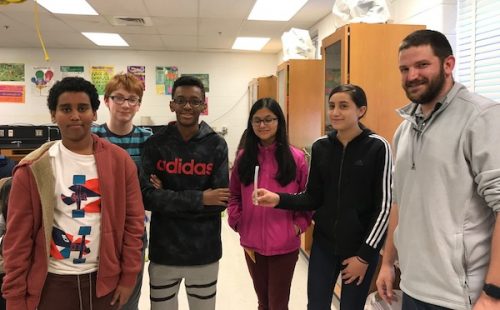
Students from Parkland Magnet Middle School in Rockville, MD, that will be conducting a microgravity experiment on concrete formation in space.
Proposal Summary:
We are going to see if the cement and steel shavings will mix in microgravity the same way they do on Earth. We will conduct an experiment on Earth first to see how the steel shavings and cement react in the normal atmosphere. Then, we would do our experiment in space and see if through microgravity the cement and steel shavings will mix, or if the steel and cement mixture from space becomes stronger than the steel and cement mixture on Earth. We will see which one is stronger by using weights, and we would keep on adding weights until one cement steel mixture cracks. We are making reinforced concrete. The way we will do this is by adding steel shavings in our cement. We will make the cement by adding aggregate and sand with Portland cement. We will see if microgravity affects this in any way such as harden it or mixing it. It will hopefully make reinforced cement. We believe that the microgravity will affect the mixing. The mixing of the steel shavings and the Portland cement will make stronger cement.
HONORABLE MENTION FINALISTS:
How do HeLa Cells Grow in a Microgravity Environment
Grade 7, Parkland Magnet Middle School, Montgomery County Public Schools
Principal Investigator: Pari Lakhiani
Co-Investigators: Nadisha Adikari, Binaya Egoda, Hildana Gizachew, Yeabsira Matiyos
Teacher Facilitator: Raymond Ekabe
Proposal Summary:
We want to figure out the effect of microgravity on the growth of HeLa cells. These cells are cervical cancer cells and are made from a combination of HPV and colon cancer cells. The cells are known to be “immortal” here on Earth and die slower than they divide. We wanted to see if these cells would be “immortal” while being tested in the ISS. We want to figure out how they react in a environment with microgravity present. These cells are interesting to think about since they are “immortal” and somehow have no cure. This can provide better HPV vaccines and other vaccines containing a deadly disease such as HeLa.
How Does Microgravity Affect How Green Algae Grows?
Grade 7, Parkland Magnet Middle School, Montgomery County Public Schools
Co-Principal Investigators: Denny Amaya, Evan Jones, Elijah Robinson, Hunter St Denis
Teacher Facilitator: Jennifer Wingate
Proposal Summary:
We want to send green algae into space to see how it grows in microgravity. We also want to send the algae with water in the same tube, but just separated from each other on their way to the ISS. This experiment will help us get a better understanding of how plants grow in microgravity. Also, it will help us find out if algae can be a reliable food source in the future for people to live in space and have a good food source.
16. University System of Maryland, Maryland
Jump to University System of Maryland’s Community Profile
SELECTED FOR FLIGHT:
Biofilm Adhesion of E. coli to Annealed Porous and Smooth Aluminum in Microgravity
Grade 13, University of Maryland, College Park, University System of Maryland
Co-Principal Investigators: Debbie Adam, Michelle Fang, Niki Gooya, Pali Keppertipola, Apurva Raghu
Teacher Facilitator: Natasha Ivanina
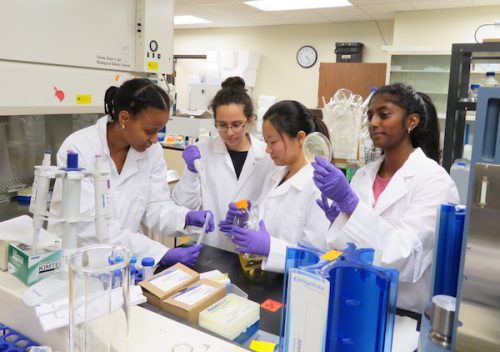
Debbie Adam, Niki Gooya, and Michelle Fang (left to right) perform preliminary experiments with LB broth and FME tubes while Apurva Raghu analyzes E. coli bacterial cultures (Swarnapali M. Keppetipola not pictured).
Proposal Summary:
Biofilms are communities of microorganisms with complex physiologies which can facilitate the development of diseases like atherosclerosis and leptospirosis. This poses a risk for health and wellness of astronauts in confined environments, meaning that deterring biofilm growth is of extreme importance on long haul missions. The great structural diversity of these microbial systems contributes to its acquisition of resistance towards antimicrobial substances through generational selection. In addition to illness, biofilms in space may obstruct the function of critical equipment. Such equipment is often constructed of aluminum alloys, as its low production costs combined with high malleability facilitate the formation of a wide range of innovative designs. We propose an experiment that analyzes the adhesion of Escherichia coli on porous and smooth aluminum surfaces to determine if smoother surfaces of aluminum garner more bacterial adhesion in a microgravity setting than a porous one. Research indicates that E. coli is capable of biofilm formation, and known for microbial surface colonization. Earlier inquiries into biofilm formation on porous surfaces show reduced microbial attachment and formation. We intend to see whether or not these results are analogous or contingent in a weightless environment. In the event we observe elevated microbial formation on annealed smooth aluminum, our experiment will suggest concurrence with current research findings. Additionally, it would be recommended that the equipment used on the International Space Station be made of porous materials. Following mission completion, biofilm growth on both the annealed porous and annealed smooth aluminum samples will be analyzed via confocal microscopy.
HONORABLE MENTION FINALISTS:
The Effect of Microgravity on DNA Damage Response
Grades 13 and 15, University of Maryland, College Park, University System of Maryland
Co-Principal Investigators: Lena Franklin, Benjamin Gross, Samuel Howard, Abhirami Thaivalappil, Frank Zheng
Teacher Facilitator: Hao Yiu
Proposal Summary:
The DNA damage response (DDR) is a system of cellular pathways to detect and repair lesions to DNA. When transcription and replication occurs over lesions, it frequently results mutations, which have been tied to cellular senescence, cancer, and aging. C. elegans, a species of nematode, is already used as a role model for DNA damage and DDR, and is well-suited to demonstrate the impact of DNA damage on multicellular organisms. However, prior experiments have conflicted on the effects of microgravity on DNA and DDR, with various experiments conducted in simulated microgravity producing different results. We will investigate how microgravity impacts the DDR with C. elegans in a short-term spaceflight experiment. By studying the expression of checkpoint genes, such as exo-3 and mrt-2, which are orthologs among most animals, of both a space and ground sample of C. elegans we will investigate the link between microgravity and DDR.
Micro Gravitational Influence on the Regenerative Abilities of Holothuria Thyronine Bijuu
Grades 14-15, University of Maryland, College Park, University System of Maryland
Co-Principal Investigators: Doug Bell, Daewoong Daniel Kim, Gyeongeun Hailey Lee, Will Sherman
Teacher Facilitator: Nathan Burns
Proposal Summary:
Cell regeneration and the biological processes behind this phenomenon have been a widely investigated research topic since the 1700s, and have only grown more popular with findings of superior regenerative capabilities amongst non-human organisms. If we are able isolate certain biological functions that encourage massive cell regeneration in these alternate species, we might be able to conjure remedies to enhance human regeneration and more safely push the limits of physical abilities in space. Additionally, with the rapidly expanding development and application of biotechnology, the ability to implement artificial systems that stimulate regeneration becomes ever more realistic and promising. Finding a way to augment the human condition so the dangers of space are less threatening to us is a critical innovation that will extend the perceived boundaries of our physical limitations. Astronauts aboard the ISS are subjected to conditions that leave little ability to recover from severe injuries, meaning all enhancements to natural recovery would help save lives. As missions into space grow more extensive and lengthier, these dangers pose an increasingly detrimental threat to researchers and might grow to be the next major roadblock of experimental discovery in space. In analyzing the regenerative properties of Holothuria Thyronine Bijuu, we hope to collect relevant data about the molecular mechanisms to demonstrate proof of concept and lay the way for more advanced studies on vertebrates. Inconsistencies in cell regrowth will point to gravitational involvement and suggest how to augment biology to make space safer.
17. Fitchburg, Massachusetts
Jump to Fitchburg’s Community Profile
SELECTED FOR FLIGHT:
How is the Growth of the Bacteria Frankia alni Affected by Microgravity?
Grade 10, Montachusett Regional Vocational Technical High School
Co-Principal Investigators: Camille Haas, Elizabeth Moylan
Co-Investigators: Abigail Floyd, Jacob Hollowell, Jason Martin
Teacher Facilitator: Paula deDiego
Proposal Summary:
Our project proposal is designed to answer one question: How is the growth of Frankia alni affected by microgravity? F. alni is a nitrogen-fixing bacterium that forms a symbiotic relationship with many actinorhizal plants. By inducing the formation of root nodules, it is able to provide all of the nitrogen requirements of the plant in environments where nitrogen is a limiting factor to the plant’s growth. In addition, F. alni is one microbe that dwells within activated sludge in wastewater treatment plants. While the bacterium isn’t harmful in controlled quantities, the excessive growth that tends to occur causes operational problems, hazardous working conditions, and effects on solid separation in wastewater treatment plants. In order to test the growth of F. alni in microgravity, we will be using a growth medium to instigate bacterial growth for fourteen days, before unclamping the protozoal growth inhibitor, Puromycin. The insight gained from conducting our experimental design will greatly increase our understanding of the growth of F. alni in microgravity, allowing us to take greater advantage of the benefits of F. alni in regards to the growth of valuable actinorhizal plants while minimizing the potential risks concerning wastewater treatment.
HONORABLE MENTION FINALISTS:
How does Ideonella sakaiensis Degrade Plastic in Space Compared to here on Earth?
Grade 10, Montachusett Regional Vocational Technical High School
Co-Principal Investigators: Crystal Almenas, Jacob Hollowell
Collaborators: Austin Caron, Camille Haas
Teacher Facilitator: Paula deDiego
Proposal Summary:
Ideonella sakaiensis is a revolutionary bacterium that is capable of degrading PET plastic at a tremendous rate. Does I. sakaiensis degrade plastic at a similar rate in space compared to here on Earth? Additionally, here on Earth we will conduct a ground truth by creating a replica experiment where the only variable changed is microgravity. Our experiment at the ISS will answer the question that is, do the enzymes produced by I. sakaiensis degrade at an altered rate under microgravity? Is reproduction of the bacteria altered by microgravity? If so, can I. sakaiensis be integrated into recycling systems while aboard the ISS or space colonization?
Does Microgravity Affect Recombinant Escherichia coli Gene Expression of Insulin?
Grades 10 and 12, Montachusett Regional Vocational Technical High School
Co-Principal Investigators: Anna Salter, Caleb VanHillo
Co-Investigators: Crystal Almenas, Camille Haas, Jacob Hollowell
Teacher Facilitator: Paula deDiego
Proposal Summary:
Our project involves the simple question of how microgravity affects the growth and production of insulin within the bacterium, Escherichia coli. The microbe Escherichia coli can be utilized to produce insulin used by human cells to regulate glucose. This experiment will provide insight on the efficiency of Escherichia coli in regards to human insulin production, when compared to other microbes used for the same purpose such as Trichosporon sp. In the microgravity setting, we are looking for changes in both the growth rate of the microbe itself, and the amount of insulin produced. Often, if the cell has a higher growth rate, it has a lower amount of insulin produced within each cell. To limit our observation to be purely within a microgravity environment, our capsule will contain a chamber with a growth media, and a separate chamber with the inhibitor Puromycin. Insulin is a hormone that is essential to life, by finding more efficient ways of producing this necessary hormone, we can better the lives of those who struggle with diabetes mellitus.
18. Redford, Michigan
Jump to Redford’s Community Profile
SELECTED FOR FLIGHT:
Can Peppermint Seeds Germinate in Space?
Grade 8, Hilbert Middle School, Redford Union School District
Co-Principal Investigators: Destinee Chaney, Joseph Clark, Ethan Cuevas, Ada Mahar, Dontez Robison
Teacher Facilitator: Maureen Lemon
Proposal Summary:
In microgravity, astronauts’ muscles will grow weak and we think peppermint will help them. Peppermint is a very useful plant. It helps indigestion, anxiety, muscle pain, stomach pain, headaches, and also helps coughs and colds. Also in space, peppermint, peppermint tea, and regular peppermint leaves can help keep astronauts’ muscles healthy. Astronauts also suffer from depression and anxiety. Sometimes it is from the fact that they are in space, or because of not seeing their family. We thought of helping astronauts and learned that peppermint is good for depression, even by having a small garden people can become less lonely. We will take a test tube and have two clamps. Each section will have:
- Bottled spring water, 1.4 ml
- 5 organic Peppermint seeds and peat soil, 2.8 ml
- 10% neutral buffered formalin fixative, 2.8 ml
To perform this experiment on the ground, the only thing that would be different would be the gravity. This activity will examine how gravity may affect the growth of peppermint. If this projects works, it can help many people, including people living on Earth.
HONORABLE MENTION FINALISTS:
Do Crystals Grow Faster in Microgravity than on Earth?
Grade 7, Hilbert Middle School, Redford Union School District
Co-Principal Investigators: Anawake DeerInWater, DeMatthew Dixon, Damian Morales, Jayla Wilson
Teacher Facilitator: Maureen Lemon
Proposal Summary:
Our group is experimenting with crystal growth in space. We chose this topic because crystals can be used for very helpful medications. These medications are very useful to cancer treatments. Research has shown crystals grown in microgravity are often larger and more well-ordered than Earth-grown crystals. Research has also shown that microgravity helps crystals grow big and almost perfectly. Growing protein crystals here on Earth can be extremely difficult, or even impossible, because gravity causes some imperfections in the crystals.
Can Ginger Germinate in Microgravity?
Grade 7, Hilbert Middle School, Redford Union School District
Co-Principal Investigators: Mya Barnes, Daryl Dantzler, Joshua Griffin, Ariel Remington, Lee Stanley
Teacher Facilitator: Maureen Lemon
Proposal Summary:
We’re doing our experiment on ginger. Ginger is a flowering plant whose stem is widely used as a spice or a folk medicine. Will a ginger root germinate in space? We decided on this question by looking at the facts on ginger and because of all the things ginger can do. Ginger can cure nausea and even fight cancer cells. We also learned it could help astronauts with motion sickness. It can also help with astronauts’ muscle pain so it will be easier for them to work. In our experiment we will be designing with ginger, soil, and water. In the experiment, we will be seeing if the ginger root will germinate in microgravity. We will place the following in the test tubes water, soil, 3-5 seeds. Our group will do this experiment in microgravity and gravity.
19. Traverse City, Michigan
Jump to Traverse City’s Community Profile
SELECTED FOR FLIGHT:
The Growth of Bacillus Subtilis on a Substrata Material in Microgravity
Grade 9, Traverse City West Senior High School, Traverse City Area Public Schools
Co-Principal Investigators: Hattie Holmes, Langley Nelson
Co-Investigators: Kale Cerny, Lainey Wickman
Teacher Facilitator: Patrick Gillespie
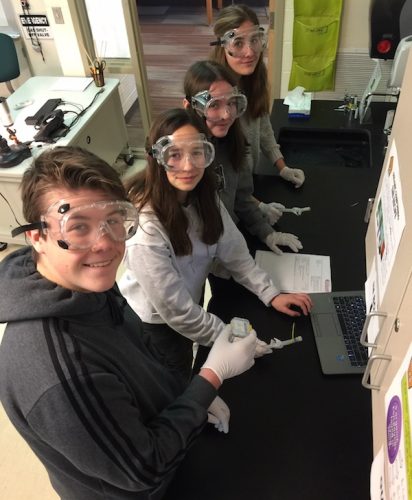
Kale Cerny, Hattie Holmes, Langley Nelson and Lainey Wickman- 9th grade honors biology students, making sure a silicon wafer required for their microgravity experiment on Turbatrix Aceti will fit in the mini-lab.
Proposal Summary:
We are testing the effect that microgravity has on biofilm growth of Bacillus Subtilis on a substrata material. We will be measuring biofilm mass, thickness and architecture. Control experiments will be performed on Earth to replicate those performed on the International Space Station (ISS).
HONORABLE MENTION FINALISTS:
The Effect of Microgravity on Turbatrix Aceti Reproduction and Growth?
Grade 10, Traverse City West Senior High School, Traverse City Area Public Schools
Co-Principal Investigators: Lydia Derks, Lillian White
Co-Investigators: Maggie Bottoms, Lauren Phend, Mira Wilson
Teacher Facilitator: Patrick Gillespie
Proposal Summary:
Turbatrix Aceti, commonly known as Vinegar Eels (Phylum Nematoda), reproduce the same way humans do; with eggs from the female, and sperm from the male. A male and female specimen can reproduce up to 45 offspring every 8-10 days. The Turbatrix Aceti live in raw vinegar (primarily raw apple cider vinegar), and feed off the nutrients provided by the liquid. This, paired with their long lifespan of up to 10 months, makes them quintessential for a long sustaining population. The organisms are also a sufficient source of nutrients for fish, which are part of a balanced diet for humans. The present information shows how the Turbatrix Aceti are perfect for space-travel; they are low-maintenance organisms that thrive in dark places, as well as an almost self-sustaining population. As a result, we will be sending three male and three female specimen into space to see if sexual reproduction and growth is different in a microgravity environment than here on Earth.
Effects of Microgravity on Copper Sulfate Crystal Growth
Grade 10, Traverse City West Senior High School, Traverse City Area Public Schools
Co-Principal Investigators: Jessie Chan, Quinn Provencher
Investigator: Zachary Rothstein
Collaborator: Jacob Powers
Teacher Facilitator: Patrick Gillespie
Proposal Summary:
Gravity causes crystals to grow with imperfections. In space, with microgravity, we could grow perfect crystals without the interference of gravity. To test our theory, we are creating copper sulfate crystals with the aid of calcium chloride to help the crystals form. The growth of crystals is important because with new technology the demand of crystals has increased significantly. If crystals grown in space come back larger and purer than the ones grown on Earth with gravity, we can study the crystals’ differences in areas such as structure, size, and purity and use that knowledge to improve our crystal growth here on Earth. In addition, crystals are often used in creating drugs and medicines; if we can figure out how to grow high-quality crystals in space, we could improve the creation of drugs and medicines on Earth. From previous studies conducted in space involving crystal growth, it has been observed that crystals have fewer imperfections and increased size compared to crystals grown on Earth.
20. Kansas City, Missouri/Kansas
Jump to Kansas City’s Community Profile
SELECTED FOR FLIGHT:
The Growth of Mint in Microgravity
Grades 7-8, Coronado Middle School, USD 500
Co-Principal Investigators: Uhunoma Amayo, DaQuon Cheadle, Jimenez Reyes, Daleshone Sharkey
Teacher Facilitator: Erin Henry
Proposal Summary:
We propose to answer the following question: Can mint successfully grow as well in space as it does on Earth? We want to see the growth process of mint in space. We would like to see this happen because we want to make life on the International Space Station more comfortable for the astronauts. Mint is a calming herb that has been used for thousands of years to help people with stomach problems (LD, 2017). Mint is very good for people’s health. We also know that mint can help in other ways, such as reducing fevers and producing better cholesterol health. Mint is rich in nutrients and also helps gas and indigestion (LD, 2017). Mint is great for soothing sore throats when combined with tea. Mint can improve Irritable Bowel Syndrome and it has also been known to improve brain functioning (LD, 2017). Our hypothesis is based on the experiment where astronauts proved that crystals grow better in space, so we are conducting a similar experiment using mint. We believe that mint will grow as well in space as it does on Earth because we already know that mint can grow with little to no sunlight. We think that mint will grow better in microgravity.
HONORABLE MENTION FINALISTS:
The Effects of Mold Growth On Blueberries In Microgravity
Grades 7-8, Argentine Middle School, USD 500
Co-Principal Investigators: LaMaya Alexander, Mwangaza Chobole, Nohomay Lopez, Avieser Pacheco, Carina Perez, Fazilla Uwimana
Teacher Facilitator: Alexander Taylor
Proposal Summary:
Do cells regenerate faster in space or on Earth? We will test this theory by sending four grams of a blueberry to space to see if mold will grow faster or slower in space than it does on Earth. The astronauts will record the amount of mold covering the blueberries, then we will compare them to the results we take here on Earth. We chose to do this experiment because if the mold doesn’t grow as fast as it does on Earth, we could send other organisms with the same genetic make-up that could be resourceful to the colonization of space maybe such as humans who are sick. Their cells would regenerate faster and speed the healing process.
The Efficacy of an Organic Mold Killer Treatment in Microgravity
Grades 7-8, Coronado Middle School, USD 500
Co-Principal Investigators: Stephanie Arroyo, Marleen Carmona, Leah May Perrin
Teacher Facilitator: Erin Henry
The purpose of our experiment is to determine the efficacy of an organic mold killer to treat mold on cilantro in microgravity. The organic mold killer is a solution comprised of the essential oil of Melaleuca alternifolia (tea tree oil) and water. In a Type 2 FME Mini-Lab, mold will grow on cilantro microgreens, then be treated with an organic mold killer treatment. When the FME Mini-Lab returns from flight, we will investigate and will compare the in-flight experiment with the in-lab experiment on Earth. Our hypothesis is that use of an organic mold killer solution will alleviate the effects of mold on cilantro in microgravity. Our experiment is important because our findings can support the use of effective natural mold killing treatments while in space and here on Earth.
21. Clark County, Nevada
Jump to Clark County’s Community Profile
SELECTED FOR FLIGHT:
Will Quinoa Grow in Microgravity?
Grade 5, J. Marlan Walker International School, Clark County School District
Co-Principal Investigators: Colin Brandel, Hunter Dodds, Spencer F., Roman Medina, Baron Petersen
Teacher Facilitator: Pam Locascio
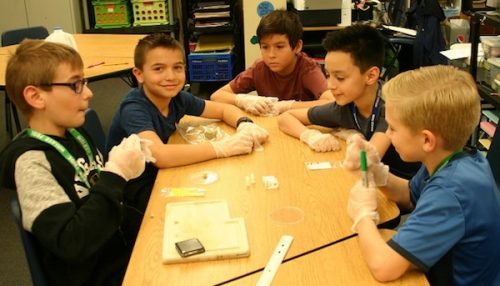
Student team at Walker Elementary School that will be conducting a microgravity experiment on Quinoa growth aboard ISS.
Proposal Summary:
Our proposal question is “Will Quinoa Grow in Microgravity?” Quinoa (Chenopodium quinoa) is high in protein and nutrients. Quinoa is additionally high in fiber, phosphorus, magnesium, iron, potassium, calcium, B vitamins, vitamin E, and many other beneficial antioxidants. It is very full of protein, loaded with fiber, and has a lot of iron. Quinoa has a lot of riboflavin (B2). B2 can help with muscles and brain cells. This seed also will help prevent cardiovascular disease. Quinoa is gluten-free which will definitely help in a case where someone is gluten intolerant. There are many ways quinoa can be beneficial. If quinoa can be grown in microgravity, it would be an extremely healthy food for the astronauts to eat. In our experiment, we will be using the type 3 FME mini-lab with 10 quinoa seeds embedded in rockwool, spring water, fertilizer, and a liquid to stop the growth. We will be looking for a similarity between quinoa germination in space and germination down on Earth. We will compare how many seeds germinated.
HONORABLE MENTION FINALISTS:
Will Garden Cress Germinate in Microgravity?
Grade 5, Doris French Elementary School, Clark County School District
Principal Investigator: Kate Abayan
Collaborators: Victoria Barreto, Rhiannon Post
Teacher Facilitator: Marie Roberts
Proposal Summary:
The question we are going to be asking is: Will microgravity affect the germination of the micro plant cress? Garden cress is a micro plant packed with nutrients. It has phosphorus and calcium, something that astronauts lack when they go up into space. Astronauts need this for their bones to grow because the Sun is not there to give the astronauts nutrients for their bones, which is the equivalent to phosphorus and calcium. Astronauts lose 1% – 2% of their bone mass each month that they are up there (Forbes, 2016). Cress is very easy to grow, having most of them sprout in up to five days. We will be separating our test tube with two clamps. One will have just the cress seeds. We will be using a fixative, Formalin, to stop the growth of the plant when it returns to the Earth to be observed. The last thing we’ll be using is some sort of soil substitute, paper towel, fabrics, etc. This project will help astronauts in their health problems.
Germination of Cauliflower and Its Health Benefits
Grade 5, Doris French Elementary School, Clark County School District
Co-Principal Investigators: Miguel Bautista, Alexa Cruz, Whitney Ho
Teacher Facilitator: Marie Roberts
Proposal Summary:
The question our group is asking, is: Will cauliflower germinate in microgravity? Astronauts lose 1% of bone mass each month in microgravity (Malik, Tariq, 2016). So our group learned that 840 g of cauliflower has 404.9 mg of vitamin C, 126 mg of magnesium, and 185 mg of calcium (Food Composition Databases Show Foods). Vitamin C is needed for normal bone development and for the formation of collagen (Doheny, 2008). Collagen is the major component of connective tissues (4 Surprising Benefits of Collagen for Joint and Bone Health). Calcium helps your bones stay strong (Eunice) and magnesium assures the strength and firmness of bones and makes teeth harder (Brown, Susan E. Key Minerals for Bone Health – Magnesium Better Bones, 16 Nov. 2016.) If Cauliflower could grow in microgravity it would increase bone mass in astronauts. Eating cauliflower would be better than taking vitamin C pills or magnesium pills because cauliflower can help detoxify astronaut’s bodies. (10 Detox Benefits of Cauliflower, February 2, 2016). Cauliflower needs cool and humid conditions to grow (Old Farmer’s Almanac, October 23, 2018). We will use cut up sponges to grow the Cauliflower. We will use club soda so we can grow the Cauliflower with no soil. To see what happened in space we will use the fixative called formalin. We will use 35-40% of formalin to see what happened in space (Definition of Formalin, MedicineNet).
22. Galloway, New Jersey – Stockton University
Jump to Galloway’s Community Profile
SELECTED FOR FLIGHT:
Analysis of Double-stranded Break Repair in Haploid Saccharomyces cerevisiae Under Spaceflight Conditions
Grades 13-16, Stockton University
Co-Principal Investigators: Matthew Elko, Joseph Romanowski, Daniel Stoyko
Teacher Facilitator: Dr. Michael Law
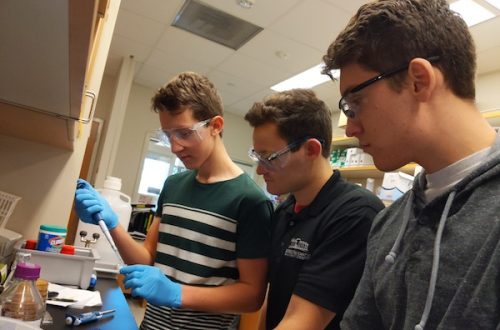
Undergraduate Stockton University students Daniel Stoyko , Mathew Elko and Joseph Romanowski prepare yeast for their Mission 13 SSEP experiment on mutation in space (photo credit Susan Allen).
Proposal Summary:
With the advancement of space age, humans spend increasing amounts of time in spaceflight. To ensure their well-being, all health-risks associated with spaceflight conditions have to be studied in great detail. Arguably, the most concerning of such risks is DNA damage which may contribute to cancer. Double-strand breaks in DNA (DSB) are well known to be causes of chromosomal aberrations that result in carcinogenesis. One of the pathways responsible for the repair of such DSBs is non-homologous end joining (NHEJ). Although NHEJ generally prevents cancer, there is sufficient data suggesting that NHEJ is the cause of carcinogenesis in certain conditions. For this reason, it is important to study the mechanics of NHEJ under microgravity and space radiation (spaceflight conditions). This project will use type 3 FME NanoRacks mini-lab to expose actively dividing Saccharomyces cerevisiae to bleomycin, a DSB inducing agent, for two days. The experiment will then be stopped by fixation using a final concentration of 4% paraformaldehyde. Once the sample returns to Earth, DSB repair will be quantified using a combination of cytological and molecular assays that can measure unresolved DSBs. The data from these methods will provide information regarding rate of DSB repair, expression of NHEJ related genes, and rate of mutations induced by NHEJ in spaceflight compared to on Earth.
HONORABLE MENTION FINALISTS:
The Green Fluorescent Protein Gene-based Expression of Escherichia coli B Membrane Proteins in Microgravity
Grade 13, Stockton University
Principal Investigator: Logan Armour
Collaborator: Ashley Noble
Teacher Facilitator: Dr. Peter F. Straub
Proposal Summary:
This experiment would test the effects of microgravity on E. coli B and how microgravity alters the expression of Green Fluorescent Protein (GFP). GFP is utilized within Biology to study protein formation, protein mobility, lipid localization, cell’s pH etc. Being able to utilize GFP for various research purposes makes it important in microgravity. Experimentation on Escherichia coli in microgravity is the most reasonable host in microgravity because it’s commonly used as a host for membrane proteins on Earth. The gene expression of Green Fluorescent Protein can be expressed in a variety of organisms (fish, mammals including humans) if inserted correctly. On Earth, GFP is a commonly used tool and microgravity could have effects on its expression in the genome. It has already proven that while in microgravity E. coli changes shape making it more resistant to antibiotics. Therefore, the transformation in shape for E.coli or the higher resistance to antibiotics could result in lower or higher amounts of GFP expressed, if any is expressed at all. GFP doesn’t need any enzymes to assist the color change when the gene is present. Not needing additional enzymes makes GFP more controlled because it limits the amount of factors acting on the E. coli to only microgravity.
The Effects of Microgravity on the Tensile Strength of Bombyx mori Silk
Grade 13, Stockton University
Principal Investigator: Ashley Noble
Collaborator: Logan Armour
Teacher Facilitator: Dr. Jason Shulman
Proposal Summary:
The purpose of this experiment is to test the effect that microgravity has on the tensile strength of Bombyx mori silkworm silk production. The expectation is that the protein crystallization of the silk will be affected by microgravity and its tensile strength will increase. The Bombyx mori are considered to be the best silk producers according to the U.S. Department of Agriculture. They have been used to create silk for clothing industries as well as body armor and medical sutures. Its tensile strength and temperature regulation make it a versatile product. This experiment will compare the tensile strength of individual silk strands formed by Bombyx mori on the ground to that of silkworms on the ISS. The benefits of silk are numerable and may be widely used in space station environments in the near future.
23. Ocean City, New Jersey
Jump to Ocean City’s Community Profile
SELECTED FOR FLIGHT:
The Effect of Microgravity on the Hatch Rate and Development of Artemia salina
Grades 10-11, Ocean City High School, Ocean City School District
Co-Principal Investigators: Abigail Craige, Alexia Schmidt
Collaborator: Steven Myers, Madison Morgan
Teacher Facilitator: Catherine Georges
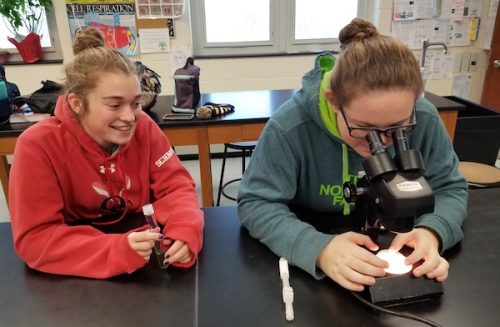
Abigail Craige checks the size of recently hatched Artemia salina as she and her Co-Principle Investigator Alexia Schmidt investigate best options for optimizing their experimental design.
Proposal Summary:
Brine Shrimp, Artemia salina, have been found to be reliable subjects when experimenting in orbital space and microgravity. A. salina can be easily transported into space as a dormant cyst, and then reactivated by saltwater in space. It is theorized that A. salina can be an important link in a space-based food chain. Fecal waste produced by astronauts can be broken down and ingested by algae. The algae is then eaten by the A. salina which can then either be eaten by astronauts or a larger predator, like a fish. B.S. Spooner et al showed that the exoskeleton of A. salina grows at a faster rate in a microgravity situation, but to the same size as on Earth. Therefore, we ask how many A. salina will be activated, what stage in their life cycle are they at and, the ratio between male and female A. salina. Upon arrival in the International Space Station, the A. salina cysts will be exposed to synthetic saltwater and will then hatch and grow. After twelve days, the experiment will be terminated with the application of a fixative, formalin. Formalin will kill the A. salina and stop any growth or decomposition, so the sample will be analyzed in the condition as terminated in space. The information collected in this experiment could be helpful to improve our knowledge of space-based food production for future extended space missions.
HONORABLE MENTION FINALISTS:
The Breakdown of Urea Using Urease from Proteus mirabilis
Grade 10, Ocean City High School, Ocean City School District
Principal Investigator: Nicholas Chiccarine
Collaborators: Henry Souto
Teacher Facilitator: Catherine Georges
Proposal Summary:
For the advancement of space travel, the effects of microgravity on the breakdown of urea using the enzyme urease produced by microorganisms is vital and must be evaluated. Using Proteus mirabilis, a rapid urease-positive organism, we intend to study the conversion of urea to ammonia in microgravity. Proteus mirabilis is a common gram-negative bacteria found in the human gastrointestinal tract, water, and soil. The ability for this microorganism to activate the production of urease upon the presence of urea is crucial in our experiment design. In our experiment, we will combine Proteus mirabilis with urea on Earth and in space to compare the results for the effectiveness to produce ammonia. Urea, a byproduct of wastewater recycled on the space station, has no application in space. However, the enzyme urease can catalyze the hydrolysis of urea into carbon dioxide and ammonia, of which, ammonia has multiple beneficial qualities for space travel. As a light refrigerant, ammonia can be used on the International Space Station in the External Active Thermal Control System. We hypothesize that microgravity will affect the Proteus mirabilis and limit the conversion of urea to ammonia by urease. A secondary outcome of our experiment will be the bactericidal effect of Amoxicillin antibiotic on Proteus mirabilis in space. This experiment proves integral in the understanding of the efficiency of urease hydrolysis in microgravity.
The Prevention of Osteoporosis in Microgravity: An Evaluation of Nacre Proteins Ability to Nucleate Apatite in Microgravity
Grade 10, Ocean City High School, Ocean City School District
Principal Investigator: Madison Morgan
Co-Investigators: Jordan Berry, Margaret Worchel
Teacher Facilitator: Catherine Georges
Proposal Summary:
It is known that microgravity environment leads to bone loss in astronauts. Since the human body does not have to work against Earth’s gravity pull, the reported bone loss is 1% per month. Therefore, it is important to find ways to mitigate bone loss in humans during their time in space. There is sufficient in vitro and in vivo evidence proving nacre’s, a naturally occurring composite material, which the marine oyster Pinctada maxima produce, impact on osteoblast function and direct bone growth. Nacre can change the cellular microenvironment and cause functional changes in osteoblasts. Biominerals like bone and nacre both have cells that are responsible for laying down the minerals. Additionally, both have proteins responsible for ordering the minerals that are laid down so they form in the proper orientation. Those same proteins can nucleate the same kinds of apatite found in bone. Since osteoblast activity is reduced, we hypothesize that having a better nucleator of apatite might help in weightlessness. We want to know if microgravity affects the ability of these nacre proteins to nucleate apatite. To test this, we will use a coverslip with nacre proteins and a phosphate neutral buffer to maintain a balanced pH level. We will use a hypertonic calcium solution and a hypertonic phosphate solution to induce apatite formation. There will be no use of a fixative here because nacre is acellular. If the apatite formation by nacre is unaffected, this may point to its suitability as a bone repair agent.
24. Springfield, New Jersey
Jump to Springfield’s Community Profile
SELECTED FOR FLIGHT:
Triops longicaudatus Growth and Development in Microgravity
Grade 7, Florence M. Gaudineer School, Springfield Public School District
Co-Principal Investigators: Ava Fidalgo, Sarah Lumas, Miriam Pereira, Lakela Whitney
Teacher Facilitator: Alison Gillen
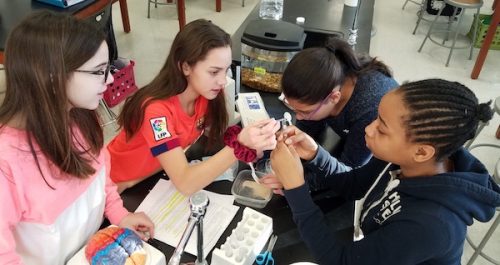
7th graders Ava Fidalgo, Lakela Whitney, Miriam Pereira, and Sarah Lumas separate and prepare triops eggs for their experiment.
Proposal Summary:
Triops longicaudatus are aquatic crustaceans that live in small bodies of water. Their eggs can live without water for long periods of time. We would like to send T. longicaudatus eggs to the International Space Station to see if their eggs will hatch in microgravity and if they do hatch, how will they develop. T. longicaudatus eggs are easy to send to space because they are so small and are dormant for long periods of time. Once water is introduced, the eggs are activated and can start their growing process. Our plan is to put the T. longicaudatus in the type 3 FME mini lab with 2 clamps. Section 1 will have 10 T. longicaudatus eggs and 1 pellet Triops food to feed them once they start growing. The second section will have 5 ml of Poland Spring water that will be added once they reach space. The T. longicaudatus will have about a month to hatch and develop. Our expert told us that only a fraction of the eggs in each batch will hatch. We expect 20-25% of the eggs to hatch. The third section will have 1 ml of 10% Neutral Buffered Formalin to stop them from further development. Understanding how organisms develop and grow in microgravity will help us as we attempt to establish colonies in space. Dr. David E. Cowley says “Imagine if the secret of suspended development in Triops someday enables people to explore another solar system or galaxy!”
HONORABLE MENTION FINALISTS:
The Effect of Microgravity on Chia Seed Germination
Grade 9, Jonathan Dayton High School, Springfield Public School District
Co-Principal Investigators: Jenna Lashuk, Max Levy, Joey Lucarello
Teacher Facilitator: Irene Ornovitz
Proposal Summary:
Our question is “Will it be possible for chia seeds to grow in microgravity?” We have decided to test the effects of Chia seeds in microgravity because Chia seeds are a superfood with tons of protein. Protein is hard to access in space, so having another source will be beneficial to the astronauts. Chia seeds are rich in polyunsaturated fat, omega-3 fatty acids, fiber, protein, calcium phosphorus and zinc. All of these vitamins and minerals are crucial to the astronauts diets. Also, Chia seeds take only 4 to 7 days to sprout which is quick and convenient for astronauts to access in microgravity. Chia seeds do not have to be eaten or used right away and can be kept in storage to eat at a later time, if necessary. This makes it a sustainable food that is easily accessible. Testing Chia seeds in microgravity can very much influence future space exploration. Chia seeds are a food with a huge amount of protein inside it. The more protein that the human body gets, the healthier the human body, allowing humans to be more active and allowing them to become more interactive on the ISS. Finding foods that allow humans to store a great amount of energy is vital in the process of finding life on Mars and other planets. Foods with proteins are also vital to have when, one day, living on other planets is possible. Using the FME 3 container, we hope to find that it is possible for more protein to be available in microgravity.
25. Jefferson County, New York
Jump to Jefferson County’s Community Profile
SELECTED FOR FLIGHT:
Rust Investigation
Grade 6, Harold T. Wiley School, Watertown City School District
Co-Principal Investigators: Ryan Arca-Steel, Agnika Ghatak, Alexander Higginbotham, Skyye Mee-Thomas, Mallary Williams
Teacher Facilitator: Ann Fillhart
Proposal Summary:
We propose to answer the question: Is rust removed faster under microgravity or on Earth? Rust can be anywhere, on cars, nails, or even structures. The more that our apparatuses rust the more we have to try things to remove rust. We need to know safe ways to remove rust in microgravity. In the FME, volume 1, we will pour distilled white vinegar. In volume 2, we will place a rusted screw. In volume 3, we will place distilled water. The distilled white vinegar will remove the rust from the screw. The distilled water will dilute the vinegar and slow down the rust removal process while the experiment is being shipped back to us. We will run this investigation on the ISS and on Earth. We will test the difference in the speed of how fast the rust is removed after the experiment by comparing the differences in weight of the two rusted screws. In the future, if mankind has to live in space, they will still need oxygen, which can cause items to rust. This experiment will test how rust removal works in microgravity. If an important piece of machinery rusts everyone on board can be in danger. If we know how best to remove rust in microgravity, we can work our way to a safer future in space.
HONORABLE MENTION FINALISTS:
How Does Aloe Vera Germinate in Microgravity?
Grades 4-5, Jefferson County 4-H, Cornell Cooperative Extension of Jefferson County
Co-Principal Investigators: Gavin Harris, Reegan Olsen, Hannah Zukas
Teacher Facilitator: Sabrina DeRue
Proposal Summary:
We propose to the answer the question: “Does Aloe Vera germinate faster and better in microgravity than on Earth?” Aloe Vera is useful on Earth for many medical and nutritional purposes. If it can grow in microgravity it will have many medical and nutritional purposes on the space station. If this will grow in microgravity it can help with the sustaining of life in space. There are over 40 uses for Aloe Vera. Some of them are that it is a great moisturizer for your skin, treats burns, helps heal bruises, heals sunburns, stops itches and stinging pain from bug bites, stops damage from frostbite, stops some rashes, makes feet as soft as a baby’s foot, fights Athlete’s foot, relieves blisters, antidote to allergic reactions, prevents pimples, soothes Psoriasis and it prevents scarring and stretch marks, just to name a few. We propose to start the germination process on the International Space Station by sending aloe Vera seeds into space to see if it will germinate any different in microgravity. Once it comes back to Earth we will study the length, width, depth, color, amount of leaves, amount of roots, and compare under a microscope for differences that may not be able to be seen with just the human eye. This will allow us to see the differences between both the project implemented on the Space Station and the one we completed on Earth.
The Impact of Microgravity on Structural Integrity and Corrosion of Carbon Steel
Grade 10, Immaculate Heart Central High School
Co-Principal Investigators: Mallory Loving, Ilianna McCaskill
Teacher Facilitator: Mitch McCormick
Proposal Summary:
This experiment would test the impact of microgravity on the corrosion of steel. The experiment would include a type 3 FME. In volume A, a carbon steel tensile test specimen will be placed to be exposed to oxygen only as a control test. In volume B, water and sodium chloride will be mixed to be released into volume C after arrival on the ISS. Volume C will contain another carbon steel tensile test specimen which will corrode when mixed with the salt water from volume B, this will be the treatment test. Upon return to Earth, all specimens will be subject to a tensile test to determine structural integrity. The specimens will also be observed under a microscope to determine if the iron oxide crystal structures (rust) have formed differently in space as to compared to that on Earth. This would benefit a better understanding on structural integrity and corrosion of metals for space travel. It would gain an understanding of how much and how long water could be held when commuting for a long period of time. It would also include the possibility of storing refined metals that could be used for construction in space (ie. space stations, lunar bases, or future colonies).
26. Suffolk County, New York
Jump to Suffolk County’s Community Profile
SELECTED FOR FLIGHT:
Effect Of Microgravity On Effectiveness On Probiotics
Grade 5, Birchwood Intermediate School, South Huntington School District
Co-Principal Investigators: Gianni Balanos, Jacianna Chiechi, Aguedo Romano, Christina Rosploch, Jancarlos Silva
Teacher Facilitator: Barbara Wright
Proposal Summary:
Our question is: How does microgravity affect probiotics? Our group has found out that astronauts get space sickness. Space sickness includes diarrhea and anything that is brought up from Earth. On Earth we have researched that probiotics kill bad bacteria in your stomach. We have read in our research that when you add probiotics to milk, they grow microorganisms. This is the same thing that happens when a person takes probiotics. We want to find out if shelf stable milk with Blue Biology Bluebiotics will make the probiotic grow microorganisms in space. Using the type 3 FME miniature laboratory, we will test what happens to milk when probiotics are added. We will have 5.0 ml of shelf stable milk (brand is Parmalat) in volume 1. In the middle volume (volume 2) we will have contents of one capsule of Blue Biology Bluebiotics Ultimate Care. This particular brand has a wide spectrum and is used for digestive health. In volume 3 we will have Isopropyl alcohol 91% (2.8 ml). On A=0 of arrival we would like clamp A to be removed and probiotics to be shaken gently with the milk. On A+2 of arrival we would like clamp B to be opened and shaken gently.
HONORABLE MENTION FINALISTS:
Effect of Microgravity on Rusting of Iron
Grade 5, Birchwood Intermediate School, South Huntington School District
Co-Principal Investigators: Ibrahim Farooq, Kevin Hernandez, Valerie Marcia, Clariza Romero
Co-Teacher Facilitators: Ms. Kessler and Ms. Rufrano
Proposal Summary:
It is important for us to see if iron can rust in space. It will be important to us because the ISS uses iron on some things in space. Some things that are made of iron are the items used to join the wires. If iron can rust in space the astronaut’s inventions will get ruined. It could be a disaster! We’d want to know how to stop it. In the mini lab one part will be iron and the other part will have water. The astronauts will unclamp and will shake. We are expecting a chemical reaction to cause the rust but wonder whether microgravity might change that reaction.
Effect of Microgravity on Cleaning Contact Lenses
Grade 5, Birchwood Intermediate School, South Huntington School District
Co-Principal Investigators: Riley Nicol, Kaylee Herold, Tyler Francisco, Ryan Yuen, Ali Mohammad
Co-Teacher Facilitators: Mrs. Maddy and Mrs. Sheehan
Proposal Summary:
Our experiment is on cleaning contact lenses in space. This experiment could help astronauts in the future because some astronauts cannot see well, and need contacts or glasses. Glasses, because of the low gravitational pull in space, can be unusable or difficult to use. The next option is contact lenses. But contact lenses get dirty no matter where they are, so astronauts would need to clean them. We discovered that dust floats around in the ISS and doesn’t settle on surfaces, instead it floats around and can eventually get into an astronaut’s eyes. Although they have vacuums to try and get rid of the dust, the dust will still get into the astronauts eyes often, because humans shed skin cells, which turns into dust. Since astronauts do not wear their full space suits and helmet on board the ISS, there will always be more dust to deal with. We want to provide the astronauts with a good way to deal with this problem.
27. WNY STEM – Buffalo/Niagara, New York
Jump to WNY STEM’s Community Profile
SELECTED FOR FLIGHT:
The Effect of Microgravity on Bacillus subtilis on Subsequent Terrestrial Behavior
Grades 7-9, PS 198 @ 202 International Preparatory at Grover, Buffalo School District
Co-Principal Investigators: Alejandro Arrigo, Joanne Everett, Joy Elaine Everett, Solé Witt
Teacher Facilitator: Andrew Franz
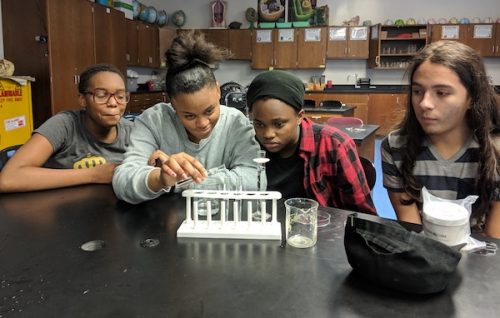
International Prep Students (Buffalo Public Schools) L to R are Sole Witt, Joy Everett, Alex Everett, Alejandro Arrigo.
Proposal Summary:
Bacillus subtilis is an extremely useful species of bacteria found in our digestive tracts, but used for industrial and medical chemical production. Whether humans do so willingly or not, this bacterium is coming to any place we venture in the universe. Our experiment, poses to study the behavior of this organism when tested on Earth after traveling in microgravity. When stressed, B. subtilis can form flagella, create antibiotics, or transfer DNA from one to another. When out of food, B. subtilis will form spores while waiting for more food to be present. We will see if these behaviors are present in the bacteria that have been active in space, a group that is dormant in space, and corresponding ground samples (one dormant and one active). This will give us insight to whether a B. subtilis can travel in space and remain useful on Earth. Differences in growth rate and genetic anomalies may hamper industrial use.
HONORABLE MENTION FINALISTS:
Microgravity’s Effect on T4 Bacteriophages’ Efficability on E. coli
Grades 11-12, Lockport High School, Lockport City School District
Co-Principal Investigators: Luke Di Fato, Jeremy Stoddard
Co-Investigators: Kiera Richards, Haley Sanders
Collaborators: William Lewis, Emily Townsend
Co-Teacher Facilitators: Shelley Bochicchio and Thomas Schultz
Proposal Summary:
Because bacteria cells have been examined to increase resistance against antibiotics in space and shape-shift due to radiation, focus has shifted onto alternative ways to prevent the proliferation of these bacteria. Historically, alternatives to antibiotics included bacteriophages and holistic herbal treatments. Bacteriophages are individual viruses, only working against specific strains of bacterial species. Because of this, bacteriophage ‘cocktails’, or bacteriophages in a stable solution, are used to treat these very specific strains of bacteria and infections. Bacteriophage research was originally conducted in the Soviet Union. Today, bacteriophages continue to be the primary form of treatment in Poland and other former Soviet satellites. This little research derived from isolation among the Western and Eastern scientific communities during the Cold War. With an average cocktail development rate of 8 to 10 years, substantial studies or discoveries have not yet been achieved (Abedon, 2016). The following type 3 FME mini lab will be conducted both on Earth and the ISS to test gravitational effects on the efficacy of T4 bacteriophages on (strain) lyophilized human non-pathogenic Escherichia coli. The E. coli will be colonized in space and ultimately introduced to the bacteriophage solution, allowing us to analyze how bacteriophages hold up against the structural integrity of E. coli. Conditions will remain relatively similar among the ground and ISS experiments, especially concerning volumetric proportions and duration of the experimental portions. Upon return to Earth, bacterial growths will be compared through quantitative means with a spectrophotometer.
The Effect of Microgravity on Methicillin-resistant Staphylococcus aureus’ Resistance to Vancomycin
Grade 12, Olean High School, Olean City School District
Co-Principal Investigators: Ethan Dalton, Tenaya Ramadhan, Coby Spiller
Co-Investigators: Aaliyah Bruner, Cassidy Sawyer
Teacher Facilitator: Laura Kopec
Proposal Summary:
Staphylococcus aureus is a type of bacteria that causes local and systemic infections, a dangerous and common issue worldwide. Various statistics indicate that S. aureus is a prominent strain of bacteria. As stated in a study on the epidemiology on S. aureus, “The prevalence of colonization with S. aureus and with MRSA was 31.6% and 0.84%, respectively, in the non institutionalized U.S. population” (Graham, Lin, & Larson 2006, p.1). New antibiotic resistant strains of S. aureus develop at a frequent rate in response to the development of new treatments by the medical community. The following experiment proposal details our plans and rationale to investigate the effectiveness of vancomycin in an environment featuring microgravity against Methicillin-resistant Staphylococcus aureus, hereafter referred to as MRSA. Methicillin-resistant Staphylococcus aureus is on the rise and has caught the attention of many organizations most notably the Centers for Disease Control (CDC). The strain of MRSA being used has increased resistance to vancomycin and provides a good basis to test antibiotic resistance under the effects of a microgravity environment.
28. Hunter, North Dakota
Jump to Hunter’s Community Profile
SELECTED FOR FLIGHT:
Kefir Water
Grade 6, Northern Cass School, Northern Cass School District 97
Co-Principal Investigators: Trey Husar, Jacob Ose
Teacher Facilitator: Laurie Salander
Proposal Summary:
The question we are focusing on is whether kefir grains will grow in size in microgravity. We chose kefir because we learned that kefir is a healthy drink, which includes many microbes. Kefir grains are also reusable and feasible. If you are able to grow kefir on the space station then, we will be able to provide a very healthy drink for astronauts. Our experiment will include one of the mini labs. In our mini lab, we are going to include four kefir grains and sugar inside volume two of the tube and distilled water in volume one of the tube. On the interaction days, the experiment will be unclamped and shaken for 45 seconds to filter the water to interact with the kefir grains. The clamp will be re-clamped and sent back down to Earth.
HONORABLE MENTION FINALISTS:
The Effect of Essential Oils in Microgravity
Grade 6, Northern Cass School, Northern Cass School District 97
Co-Principal Investigators: Hannah Gangnes, Iris Rand
Teacher Facilitator: Laurie Salander
Proposal Summary:
The question we are focusing on for our experiment is if lavender and peppermint essential oils’ fragrance react in microgravity. We decided to focus on essential oils because lavender and peppermint oils help reduce stress and motion sickness. We also thought that the fragrance of the essential oils would remind the astronauts of home when they are in space. We learned from our research that essential oils are a good benefit to your health, and it happens because of the fragrances. Our whole experiment is based off of helping astronauts find a quick and easy way to get a good, refreshing medicine that all they would need to do is smell the essential oils. Our experiment will use water, food coloring, and essential oils. We put the essential oils in the water so it would not be pure oil in the testing tube. The food coloring is for dyeing the oils to tell the difference between the two in the mini lab. The lavender oil will be dyed purple, then peppermint oil will be dyed green. We will clamp the tube in half and put the essential oils mix in either end. The mix contains 3.5 milliliters of water, two drops of food coloring, and five drops of essential oils. Our expectation for our project is that the essential oils won’t lose all of their fragrance. In space and on Earth, we also, expect to have a comparable final product from the final product on Earth and in space.
How can bone strength improve in microgravity?
Grade 6, Northern Cass School, Northern Cass School District 97
Co-Principal Investigators: McKenley Fladeland, Nora Severance
Teacher Facilitator: Laurie Salander
Proposal Summary:
The question we are focusing on is ¨How can we improve bone strength in microgravity?¨ We chose this because of a problem of astronauts losing more and more of their bone mass in space the longer they’re there and when the astronauts come back to Earth it does not come fully back. We have learned that calcium is very important to our everyday lives and not just for astronauts but helps everyone. Our experiment is to recreate a substance relatively close to stomach acid and see if a calcium pill will digest properly in microgravity. To represent stomach acid we will be using store-bought-pulp-free orange juice. We will then put a barrier in between the “stomach acid” and a calcium pill. When the pill or the remains of it get back we will see if the pill has dissolved the same way as it has on Earth. We will be seeing if they look the same under a microscope and to the naked eye. Seeing if our hypothesis is correct about digestion being the problem for the loss of bone mass in microgravity. Our experiment will include two FME 3 Mini-Labs, a calcium pill, and some store-bought pulp free orange juice.
29. Hershey, Pennsylvania – Milton Hershey School
Jump to Hershey’s Community Profile
SELECTED FOR FLIGHT:
Effects of Microgravity on the Growth of Algae Cysts and Lipid Production
Grades 9-10, Milton Hershey School
Co-Principal Investigators: Christian James, Logan Ford
Teacher Facilitator: Dr. Jaunine Fouché
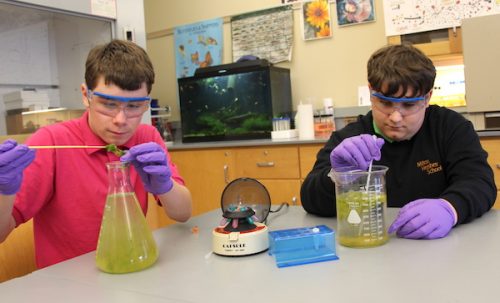
Milton Hershey School sophomore Christian James and freshman Logan Ford study algae as part of research supporting their microgravity experiment proposal on algae lipid production.
Proposal Summary:
When in unfavorable conditions, algae forms lipids. In these conditions, the algae has the ability to turn on and off different genes. This is called epigenetics. We propose the following question: What is the effect that microgravity has on the growth of algae cysts and lipid production? Upon return to Earth, we will extract the lipids from the algae and compare it to the lipids produced by the algae in the ground truth experiments, a control experiment in the sunlight and a sister experiment done in the dark. We will then see if the algae that had been in microgravity will keep producing lipids at a higher rate. If they do keep producing lipids at a higher rate, then that may mean that the epigenetic genes that were turned on, because of the stress in microgravity, will have stayed active. This experiment could be ground breaking given that making biofuel would be simplified, because the amount of time to grow enough algae to produce lipid-based biofuel could be shortened. This would enable scientists to perfect the manufacturing of biofuel in a more effective way. We will use a Type 2 FME Mini-Lab. The lab will contain 50 microliters of algae, and seven milliliters of a 3% spring water and glucose solution. We will terminate the experiment with 2 milliliters of Fix-All fixative. We hypothesize that the algae from the microgravity environment will produce more lipids than the ground truth experiment.
The Effect of Microgravity on the Adhesion and Curing of Oil-based Artist Paint
Grade 12, Milton Hershey School
Co-Principal Investigators: Aliza Blackburn, Veronica Charyton, Hunter Shippee
Teacher Facilitator: Dr. Jaunine Fouché
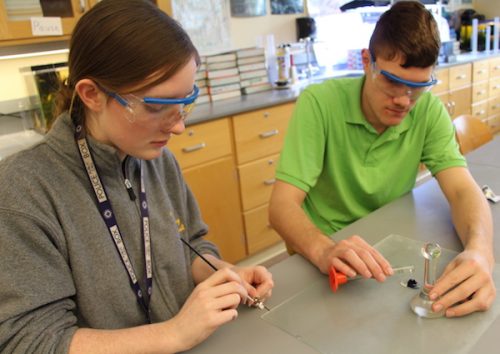
Milton Hershey School seniors Aliza Blackburn and Hunter Shippee explore the adhesion of oil-based paint.
Proposal Summary:
As technology continues to flourish and expand, it is no longer simply a science fiction idea that we will one day have humans living on other planets and in space. From a psychological standpoint, humans need more than just basic bodily care if we want to be both physically and mentally healthy. We need companionship, purpose, and entertainment — particularly artistic expression. Artistic expression is an often overlooked aspect of our human existence, and many see it as more of a luxury than a need. However, throughout history, expressing ourselves artistically, especially through the art of painting, has always been an essential component of a meaningful human life. This will not change when we go into space. Toward that end, we propose that it is important to research how oil-based paints are affected by the environment of microgravity. Our experiment will look at how oil-based paints are affected by microgravity and if they are still viable for use in a microgravity environment. Oil paints are created using a mixture of linseed or other plant-based oils and a pigment that will bond with the oil to create a range of different shades and colors. Specifically, we are testing how well paint will adhere to and cure on different surfaces when in microgravity using wood, metal, and canvas as the three different materials.
HONORABLE MENTION FINALISTS:
The Effect of Microgravity on the Symbiotic Relationship between Mycorrhizal Fungi and Red Clover
Grade 10, Milton Hershey School
Principal Investigator: Jose Rodriguez
Co-Investigators: Zoe Carey, Shamir Langley
Teacher Facilitator: Dr. Jaunine Fouché
Proposal Summary:
Is there an effect of microgravity on the symbiotic relationship between mycorrhizal fungi and red clover? This can potentially impact plant growth. Because it is able to grow in the dark and stay dormant, we plan to use mycorrhizal fungi, using the species Rhizophagus intraradices, Rhizophagus clarus, and Claroideoglomus etunicatum. We propose to examine the potential effects that these fungi have on the specific growth of the red clover, Trifolium pratense, in microgravity. Mycorrhizal fungi are appropriate for measuring growth and changes in this specific scenario (which includes a minimum of sunlight and gravity), as it is tolerant to low light conditions which will be experienced while in the microgravity environment of the ISS. Using a Type III FME, the fungi and the plant would be placed in soil in the center compartment. Another chamber would hold spring water, which would be released into the soil. The astronauts would expose the tube to light for the maximum two minutes during each interaction. The purpose of the light would be to increase any chance of growth in microgravity. The third chamber would contain Fix-all solution by Leica which is a fixative that will terminate the growth and preserve the specimens prior to the return of the samples to Earth. Because legumes are nutrient rich, the purpose of this experiment is to examine the effects of mycorrhizal fungi on legumes in the hopes that we will better understand the growth of legumes in space as a food source for astronauts.
The Effect of Microgravity on Calcium Carbonate Crystallization on Bone
Grades 11-12, Milton Hershey School
Co-Principal Investigators: Kyle Hoffman, Ankur Ghorai
Co-Investigators: Cheyenne Gausman, Marquan Kegler
Teacher Facilitator: Dr. Jaunine Fouché
Proposal Summary:
In this experiment, we are testing the growth of the calcium carbonate crystal, calcium carbonate, on bone tissue. We chose calcium carbonate because it is found in bones and sea animal shells. Calcium carbonate is the harder part of sea shells. In space, living human bone becomes less dense, especially in the hip and spine. This causes significant health issues for those living in microgravity. Since we are unable to conduct this experiment on actual, live human bone, we are using uncooked, demineralized chicken hip bone to represent human hip bone, and we are studying calcium carbonate crystallization to represent the osteoblast recrystallization process on the bone. We will conduct the same experiment on Earth. We will measure the crystals’ differences in size and shape. We will measure the bones for density differences. If the bones will recrystallize in microgravity, this may help us better understand the recrystallization process; therefore, the loss in bone density may be able to be repaired in humans.
The Effect of Microgravity on Chaos (Pelomyxa) Carolinensis While Encysted
Grades 9 and 11-12, Milton Hershey School
Principal Investigator: Diana Creech
Co-Investigators: Margaret Creech, Daniel Himes, Re’Naye Waklatsi
Teacher Facilitator: Dr. Jaunine Fouché
Proposal Summary:
Amoebae when in unfavorable conditions form cysts. The cyst protects the amoeba until it is exposed to more favorable conditions with food or water. In this encysted state, the amoebae are not affected by the outside environment and can survive in many adverse conditions (Schilde). In our experiment, we will examine the effects of microgravity on the amoeba cysts. We propose the following question: Will microgravity affect the function of Chaos carolinensis, particularly during their time in an encysted state? Encystment is a critical part of the life cycle of an amoeba. Chaos carolinensis, or giant amoeba, have a similar anatomical structure to that of a brain eating amoeba (Dee et al.). The similarity between the structures of these two different amoebae can allow one to assume they have analogous reactions to microgravity. By evaluating the effects of microgravity on giant amoeba cysts, it can be determined whether or not microgravity will affect this cycle of their life. We will reactivate the cysts upon their return to Earth to evaluate the effect of microgravity on the amoebae and their ability to function normally. We can further evaluate these effects to see if they have a potentially detrimental impact on biological systems sent into space. This knowledge can possibly aide in the development of a necessary sanitation method to prevent the spread of harmful amoebae and the subsequent contamination of biological systems in future space exploration.
Impact of Microgravity on Multipolar Neurons in C. elegans
Grade 12, Milton Hershey School
Co-Principal Investigators: Jesse Lin, Ripley VanHoosier
Co-Investigators: Yahya Bey, Florinda Good-Gonzales, Sandra Good-Gonzales, Gabriella Lugo
Teacher Facilitator: Dr. Jaunine Fouché
Proposal Summary:
It is hard to observe the effects of microgravity on neurons in humans. It is, however, easier to study the neurons in a smaller organism, such as Caenorhabditis elegans (C. elegans). By observing the structure of neurons in C. elegans after being placed in microgravity, the experiment can reveal the possible shape and structure of astronauts’ neurons after being in a similar environment, rather than the structure of the brain as a whole, to determine if there is a significant change. If the difference between the structure of neurons in microgravity and the structure of neurons on Earth is significant enough, inferences can then be drawn on what microgravity can potentially do to individual neurons in astronauts. During the time within microgravity, we expect that the multipolar neurons of C. elegans will undergo deterioration of their axons, dendrites, soma and terminal branches. Then, by comparing the results of our ground experiment to the results of our experiment in space, we can use statistical analysis to determine whether the changes differ enough between the two experiments to draw a significant conclusion from them. Should the experiment produce statistically significant findings, this will aid astronauts and scientists in the future to understand the effects of microgravity on individual neurons. This could lead to additional research and potential methods to combat any negative effects that microgravity might induce on astronauts in space.
30. Pittsburgh, Pennsylvania – University of Pittsburgh
Jump to Pittsburgh’s Community Profile
SELECTED FOR FLIGHT:
Transcriptomic Analysis of Escherichia coli Response to Ciprofloxacin in Microgravity
Grade 16, University of Pittsburgh School of Pharmacy
Co-Principal Investigators: Mohamed Kashkoush, David Katz, Anu Patel
Teacher Facilitator: Christian Gauthier
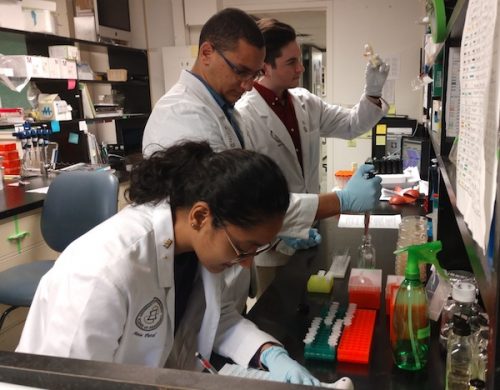
Pitt Pharmacy students Anu Patel, Mohamed Kashkoush, and David Katz conducting research in the lab on antimicrobial resistance.
Proposal Summary:
Antimicrobial resistance is a growing public health issue that has a global and even a universal effect. With the concurrently increasing frequency, duration and overall ambition of space exploration, it is important to approach the treatment of infections during spaceflight with confidence and precision. A closed, high-touch environment aboard the ISS and other space vessels, combined with increased bacterial virulence and human immunosuppression during spaceflight further highlight the importance of research into antimicrobial therapies under microgravity conditions. A troubling example of this infectious risk is highlighted from a 96-day spaceflight where a Russian cosmonaut became ill with a methicillin-resistant Staphylococcus infection after another cosmonaut was treated with ampicillin. Prior experiments have shown that bacteria undergo transcriptomic changes that result in accelerated growth and increased resistance when challenged with antibiotics in space. Building upon these principles, this proposal aims to determine the transcriptomic changes that occur in Escherichia coli with exposure to ciprofloxacin in microgravity. By analyzing the bacterial transcriptome, this project aims to further understand the mechanisms of microgravity-associated antimicrobial resistance. Specifically, this experiment will explore whether or not survival responses previously shown during spaceflight are antibiotic-specific or broadly attributable to other antibiotics. This will provide data towards constructing evidence-based guidelines for the treatment of infectious disease during spaceflight, as well as provide insight into mechanisms of antimicrobial resistance for drug development on Earth. In doing so, we can make space and Earth safer for all.
HONORABLE MENTION FINALISTS:
Effect of Microgravity on Albumin Binding of Penicillin G Procaine
Grades 16-17, University of Pittsburgh School of Pharmacy
Co-Principal Investigators: Haram Ka, Lina Shao, John Wang, Danielle Weaver
Teacher Facilitator: Dr. Kerry M. Empey
Proposal Summary:
Protein binding is a crucial component in the in vivo pharmacokinetic properties of many drugs commonly used today, especially when it comes to drugs with narrow therapeutic windows. With these drugs, e.g. warfarin, a decrease in protein binding could mean an increase in the free, unbound fraction of the drug, which could have devastating consequences if doses are not adjusted to account for changes in protein-drug binding. This proposal attempts to analyze whether the microgravity environment will alter the binding of penicillin G procaine to the lyophilized protein, bovine serum albumin (BSA), at approximately physiologic concentrations. Ammonium sulfate will be used as a fixative to precipitate the BSA. Initial versions of this proposal considered the use of warfarin due to its high albumin binding and narrow therapeutic window. However, the limitations of the mini-lab required switching to penicillin G procaine, which is stable for long periods and covalently binds to albumin, which would keep the drug-albumin binding intact upon fixation. Upon return to normal gravity conditions, penicillin that is covalently bound to the BSA will be isolated and the remaining free penicillin G procaine in solution will be assayed and compared to the experiment done on Earth. The endpoint of this experiment will be analysis of differences in serum concentration between the experiment performed in microgravity, and the control performed on Earth.
The Effects of Microgravity on Human Cytochrome P450 Enzymatic Activity
Grade 16, University of Pittsburgh School of Pharmacy
Co-Principal Investigators: Casey Gudenburr, Taylor Laffey
Teacher Facilitator: Dr. Samuel Poloyac
Proposal Summary:
The purpose of this experiment is to study the effects of microgravity on the human drug metabolism by the hepatic CYP3A4 isoform. Previous studies have shown that drugs taken during spaceflight tend to lack efficacy, and one reason could be due to the physiological changes that occur in the human body while in microgravity conditions. Currently, there has been little research performed to determine if drugs have altered pharmacokinetics due to differences in hepatic metabolism during spaceflight. Of this data, there are no studies looking at the CYP3A4 isoform, which is the most important and abundant hepatic drug elimination pathway. A FME Mini-lab with three experiment volumes will be sent into space. In zone two, there will be the CYPExpress™ room-temperature powder form of the CYP3A4 enzyme and it will mix with the first compartment containing a tris buffer and the medication probe, midazolam. In the third area there will be ammonium sulfate that will be released after the set experiment time to fix the reaction progress by precipitating the proteins until it is able to be analyzed and compared with samples on Earth. This experiment will provide crucial information regarding hepatic drug metabolism that can be utilized to help doctors and pharmacists correct the doses of medications used by astronauts in space.
31. Knox County, Tennessee
Jump to Knox County’s Community Profile
SELECTED FOR FLIGHT:
How to Produce a Synthetic Soil from Waste Generated on Board ISS
Grades 10-11, Career Magnet Academy, Knox County Schools
Co-Principal Investigators: Scott Foster, Diamond Thomas
Co-Investigators: Isabella Beal, Elizabeth Randolph
Collaborators: Katelynn Horner, Hannah Shinzato
Teacher Facilitator: Cindy Brown
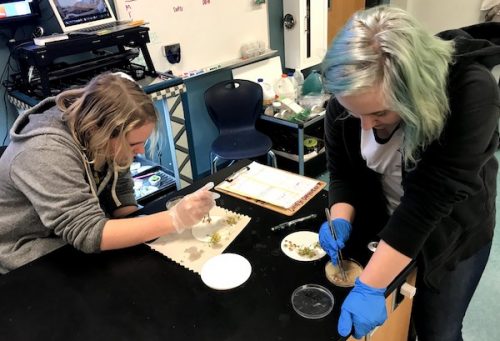
Bella Beal (left) and Ashton Phelps (right) assess effects of different water types on microgreens by determining germination rates.
Proposal Summary:
We have selected the Blue Oyster mushroom as our decomposer organism due to its various properties. We intend to test this mushroom’s ability to decompose a solid waste sample composed of “simulated” human waste, typical astronaut food scraps, and office–type wastes (Strayer, R., et. al. 2011). In the microgravity environment of ISS, we are interested in which waste components and how much sample mass can be affected by the mushroom’s enzymes. By comparing the experimental waste sample with the Earth-based control, we will analyze the impact of microgravity on decomposition rate, hyphae growth, and quantity of decomposition residue. This information will provide valuable insights to optimize conversion of waste in a microgravity environment. The second stage of our experiment is designed to assess the agricultural potential of the experimental and control media (which we will refer to as soils) to support crop production. To evaluate this potential, Microgreens have been selected for the germination and growth trials. The productivity of each soil will be determined by its crop production, expressed in terms of yield (grams biomass/grams soil). We expect to learn a great deal from the agricultural trials of our SSEP experiment. Data from these trials will provide possible future directions into extraterrestrial food production. We realize that that this initial microgravity experiment is a first step that is unlikely to produce for most Earth plants. It is our belief that with optimized decomposition systems and use of genetically engineered crop plants, sustainable food sources can be cultivated beyond Earth.
HONORABLE MENTION FINALISTS:
Herbal Antibiotics’ Effects on Escherichia Coli in Microgravity
Grade 11, Farragut High School, Knox County Schools
Principal Investigator: Taylor Sussmane
Co-Investigators: Rachel Constantin, Anja Cordell
Teacher Facilitator: Neely Tonos
Proposal Summary:
Ginger, a natural antibiotic, treats many bacterial infections including E. coli. The purpose of this proposal is to determine any effects microgravity has on the efficacy of homeopathic antibiotics. To do this, samples from microgravity and Earth will be placed in a spectrophotometer which measures absorbance, a measure of how much light a sample absorbs. If one sample exhibits a higher absorbance value, the density of bacteria in that sample is higher, therefore indicating the ginger was less effective in that respective environment. With the results, we hope to further the understanding of bacteria and antibiotic resistance in microgravity. A better understanding of these substances can lead to better antibiotics on Earth and in space, leading to safer long-term missions and better medicine on Earth. Specifically studying homeopathic medicine will expand treatments for the same ailment and reduce the amount of waste produced. In previous experiments, bacteria has proven to be more resistant to antibiotics in microgravity conditions. Having a wider variety of treatments would lead to alternative choices if a certain antibiotic proved to be unsuccessful. Furthermore, homeopathic medicine, herbal medicine, will reduce waste because the plastic packaging is futile for plants and most substances used in homeopathic medicine have multiple purposes, making it an ideal choice.
The Impact of Microgravity on the Uniformity of Chemical Bonds
Grade 5, Hardin Valley Elementary School, Knox County Schools
Co-Principal Investigators: Miles Dolynchuk, Olivia D’Cruz, Sydney Godfrey, Trinity Riddle, Ella Rodriquez
Co-Teacher Facilitators: Jessica Everitt, Lindy McCollam, Beth McCoy, Melanie Schultz
Proposal Summary:
Our experiment is on how the uniformity of Dermabond Prineo will change in microgravity. We are wondering if it will be stronger on Earth or in microgravity. If an astronaut gets a cut, he would want to know the strongest thing that would keep his wound from getting infected and seal it shut. Sometimes astronauts will get hurt and have limited resources and time. Their minds probably go straight to stitches; however, stitches are more prone to infection and would be difficult to administer without the help of a medical professional (Al- Mubarak & Al-Haddab, 2013). Dermabond Prineo is a flexible liquid adhesive that bonds to the skin. This skin closure system has two main substances, cyanoacrylate and formaldehyde. Cyanoacrylate is the main substance in super glue. Formaldehyde is a colorless, flammable, strong smelling chemical that is used in building materials and used to produce many household products. We would like to conduct our experiment in a microgravity environment because it will help astronauts in need of wound closure. Due to their job, astronauts are at risk for skin lacerations and injuries. Dermabond Prineo would provide them with a safe and cost-effective solution to these injuries.
32. Burleson, Texas
Jump to Burleson’s Community Profile
SELECTED FOR FLIGHT:
The Effects of Microgravity on the Growth of Red Wiggler Earthworms
Grade 6, STEAM Middle School, Burleson Independent School District
Co-Principal Investigators: Ashlyn Johns, Sohan Islam, Carolyne Harvey, John Irons, Sara Gutierrez Cortazar
Teacher Facilitator: Alyssa Sanchez
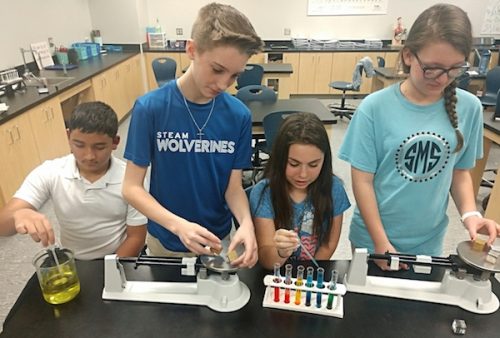
The Burleson ISD Flight team works to fine-tune their experiment volumes and calibrate measurement tools in support of their experiment assessing the effectiveness of earthworms as decomposers in microgravity.
Proposal Summary:
The question we propose to answer: Can a decomposer grow in microgravity? We are going to test to see if a decomposer can live outside of Earth’s gravity. We are going to be using earthworms as our decomposer. This will determine if gravity affects the growth of the earthworm. Earthworms are crucial to the colonization of a planet due to being a decomposer. They improve nutrients of the soil and they remove the dead roots, grass, and biotic factors and break them down. The process of breaking down organic matter to improve the nutrients of the soil. Also, earthworms are able to “worm” their way in the ground to create air pockets. These air pockets are another benefit to the soil because it allows airflow for the fertility of the soil. We are proposing a study that compares the effect of microgravity on earthworms due to the exploration of other planets that will need decomposers due to the benefits they bring to the soil. The growth of earthworms on other planets and on the ISS, in microgravity, will be beneficial for humans that will be growing vegetation outside of Earth’s gravitational influence. We are going to compare the size of the earthworms grown in microgravity to the earthworm grown in Earth’s gravity. The growth size is a determining factor if earthworms are able to further space exploration and assist with the colonization of planets as decomposers are a critical part of an ecosystem.
HONORABLE MENTION FINALISTS:
The Effects of Microgravity on Lentil Bean Growth
Grade 6, STEAM Middle School, Burleson Independent School District
Co-Principal Investigators: Macie Davis, Olivia Earley, Alex Mercer, Ava Monroe, Itzel Perez-Orozco
Teacher Facilitator: Alyssa Sanchez
Proposal Summary:
We will be attempting to answer the question: What is the effect of microgravity vs gravity on the growth of a lentil bean? We chose this test to determine if lentil beans are a solution to help bone density issues and bone degeneration while onboard the ISS. The reason we want to put lentil beans in space is because when astronauts are in space bones degenerate which means they go away and lose muscle tone. Lentil beans can help bones and muscles develop since they contain calcium, magnesium, potassium and protein. In the experiment, we hope to learn the effects of microgravity on plant growth. We hope to see if lentils grow the same in microgravity and gravity. We can also use the information gathered from the lentils to decide whether or not microgravity is a good environment for farming and developing crops and determine if lentils are an appropriate crop to grow while onboard the ISS.
Crystal Clear View On Insulin
Grade 6, REALM (Rigorous Education Arcade Learning Model) Middle School, Burleson Independent School District
Co-Principal Investigators: John Balian, Alexander Ferguson
Teacher Facilitator: Laura Smith
Proposal Summary:
Our experiment is about diabetes and Human and synthetic insulin crystallization in a microgravity environment. We feel like this is a good experiment to design because we could find out if there is a way to prevent crystallization of insulin, especially if we understand how it happens in microgravity. When insulin crystallizes, the bacteria that usually makes it viable stops working. This would cause it to be ineffective for patients in dire need of this medication. To complete this experiment we are going to keep three different varieties of insulin in a type 3 FME at the International space station (ISS) at above 65 degrees to see if it crystallizes within a certain amount of time. We will keep the experiment refrigerated at or below 40 degrees during transportation to the ISS and again after arrival back to our lab. Refrigeration slows the crystallization growth and this is how it is stored on Earth. Keeping our experiment refrigerated during transportation is an important step because the insulin crystallization growth should only be measured while in microgravity. It is also important to note that crystallization of insulin is slow so change in crystal growth will not be evident if out of refrigeration for short periods of time. We will be conducting the same experiment for our earthbound experiment. If we can understand more about synthetic insulin, maybe one day diabetic men and women can follow their passion of being astronauts.
The Effect of Microgravity On Nylon 6-10
Grade 6, Nick Kerr Middle School, Burleson Independent School District
Co-Principal Investigators: Keira Clotfelter, Jack Dietz, Tommy Gifford, Waylan Kisor
Teacher Facilitator: Allison Buckingham
Proposal Summary:
The Nylon 6-10 is used for most industrial processes and is stronger and more flexible than Nylon 6-6. It is basically liquid rope. It can be used for repairs and manufacturing. The nylon 6-10 is an industrial chemical. You probably have it in your home–toothbrushes, paint brushes and even your underwear. Nylon 6-10 is very common in many of different industries. Nylon 6-10 is a very useful product. Nylon 6-10 can behave like nylon fiber for thread or can be used for manufacturing different tools such as epoxy or fiberglass. The industrial ideas are very extensive and there are many Nylon 6-10 suppliers. Nylon 6-10 is a very flexible fiber. It consists of two chemicals called polypropylene and sebacoyl chloride to make the nanostructure for Nylon 6-10. There are other types of nylons but the one that we are using is the most flexible of all which is Nylon 6-10. The most common nylon is Nylon 6-6. We have developed several of ideas on what will happen to Nylon 6-10 in microgravity. We think that it will change the molecular structure of the Nylon 6-10 in microgravity for the better or worse. The good variable is that Nylon 6-10 might change into a very flexible, durable substance for many different applications both on Earth and in space. The less desirable variable is that Nylon 6-10 might change the molecular structure to not form any Nylon 6-10 or it might not dry by absorbing air molecules.
33. Ector County, Texas
Jump to Ector County’s Community Profile
SELECTED FOR FLIGHT:
A Novel Way to Treat a Cancer with C. sporogenes in Microgravity
Grade 6, Nimitz Middle School, Ector County Independent School District
Co-Principal Investigators: Maryam Akram, Sydney Richardson
Co-Investigators: Eva Brower, Aidan Gomez, Maison Leet, Jean Machado Torres
Co-Teacher Facilitators: Courtney Smith and Priscilla Torres
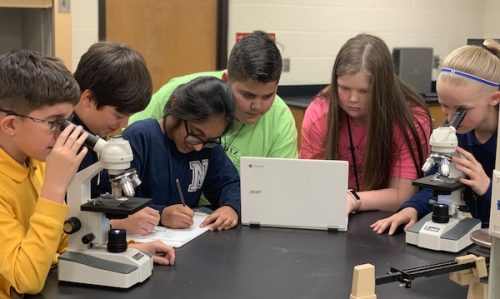
Maison Leet, Jean Machado Torres, Maryam Akram, Aidan Gomez, Eva Brower, and Sydney Richardson are the flight team for Ector County ISD.
Proposal Summary:
Radiation in space causes cancer, especially colon cancer. We are sending an anaerobic, rod-shaped bacterium that produces oval subterminal endospores named Clostridium sporogenes. We chose Clostridium sporogenes because it has been used in colon cancer treatments. It is also not pathogenic, so it is safe to fly to the ISS. The aim of this study is to treat colon cancer in astronauts with a novel method when they get exposure of radiation in space. The way our experiment will work is first we will have 2 clamps on the tube. We are going to place both 20% formalin and C. sporogenes separately into a Type 3 FME Mini-Lab tube. Section 1 will carry Clostridium sporogenes, Section 2 will carry formalin, and Section 3 will carry another batch of C. sporogenesfor control study. While in space, Clamp One will be removed after 48 hours, causing Sections 1 and 2 to mix and leaving Section 3 alone. This will cause the C. sporogenes that were in section 1 to fix and stop growing. Our end goal is to see how much the C. sporogenes changes in 48 hours versus the ones that will stay during entire trip. This experiment has a lot of potential because if this works we can use this information to treat people with other cancers while taking long voyages through space.
HONORABLE MENTION FINALISTS:
The Bioremediation of Pestalotiopsis Microspora in Microgravity
Grade 11, Falcon Early College High School, Ector County Independent School District
Co-Principal Investigators: Damien Galindo, Deidre Morales, David Tavarez, Jalen Mendoza, Rachel Rey, Nevaeh Leal
Teacher Facilitator: Elizabeth Gray
Proposal Summary:
Mushrooms are often known for possessing the ability to break down and decompose dead animals and plants. Pestalotiopsis Microspora, however, has a more unique ability: the ability to actually break down polyurethane. Considering this, we can infer that the fungus’ ability would also be able to help address some of the plastic pollution that plagues the Earth today. That being said, the progress would be very slow considering the rate at which plastic is being produced. In space, however, this could be used to prevent the position we’re currently facing on Earth. The fungi is able to break down PUR because of the mutual relationship it shares with other fungi living inside of itself. This is due to Pestalotiopsis Microspora having spores and being an endophytic fungi. The fungi is also anaerobic, meaning that it does not need any oxygen to survive or reproduce and it also does not emit any carbon dioxide or carbon monoxide, meaning it’s much cleaner and less damaging to the environment when used. Overall, this fungi will be incredibly helpful to the environment and the breakdown of many plastics. With this experiment, we could use some of the information to try and apply the fungus to Earth in a more concentrated way to make progress in the removal of the plastic pollution in our oceans and landfills. Conducting this experiment in space will also allow for us to gain a better understanding of how this fungus would function and adapt in microgravity.
34. Klein, Texas
Jump to Klein’s Community Profile
SELECTED FOR FLIGHT:
The Effect of Self-Assembled Monolayers on Microgravity Protein Crystallization
Grades 11-12, Klein High School, Klein Independent School District
Co-Principal Investigators: Yannie Guo, Max Hall-Brown, Michael Ji
Teacher Facilitator: Vicki Hermsdorf
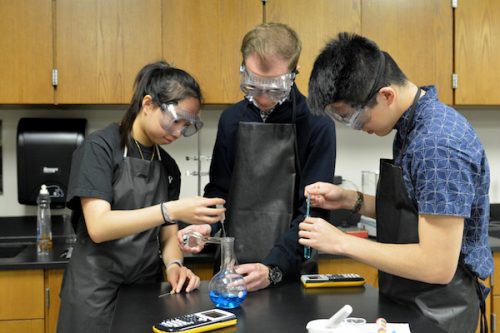
The student flight team that will be studying the effect of self-assembled monolayers on protein crystallization in microgravity.
Proposal Summary:
The proposal is an extension of previous research into protein crystallization, which has shown that microgravity and the presence of a self-assembled monolayer (SAM) can each independently improve the efficiency of protein crystallization. However, as no research has yet been done to demonstrate the combined effects of microgravity and SAMs, our research attempts to determine whether a treatment of both in conjunction will improve crystallization, as measured by crystal purity and size, even more than either factor would individually. If the experiment does result in improvement, this could have far-reaching impacts, ranging from medical treatment to biochemical research into the structure of biological compounds. For example, if the process can produce higher-quality lysozyme crystals, then it will also be able produce higher-quality insulin crystals, allowing a greater variety of diabetes research.
HONORABLE MENTION FINALISTS:
Viral Therapy of Bacterial Infections in Microgravity Settings
Grades 10 and 12, Klein Oak High School, Klein Independent School District
Co-Principal Investigators: Rishabh Ghosh, Joseph Martinez, Joshua Martinez, Vinh Nguyen, Eric Wells
Teacher Facilitator: Dr. Margaret Mason
Proposal Summary:
Bacterial infections pose substantial problems in microgravity as they have the ability to kill and infect in fractions of normal time (Love, 2016). In addition to increased danger, antibiotics are shown to be less effective in space because bacteria show reduced lag phase, increased virulence, and heightened biofilm production (Dunbar, 2013). Thus, to counter virulent bacteria, our group proposes an alternative to bacterial infection in space‒phage therapy. There is increased potential for the success of phage therapy in space because cytokine regulation of bacteria is hindered due to failure of immune responses leading to bacteria being more prone to viral infection in microgravity conditions. For this reason, our group will investigate how bacteriophages affect bacteria in microgravity. The results from this study are immense as they lead into further research about phage therapy in microgravity, which, if viable, could tremendously help people and save lives in future space colonies. To perform the experiment, we will place E. coli bacteria into agar cultures and will perform an artificial bacteriophage infection inside an FME on the ISS. To analyze the results, the group will be performing serial dilutions of the E. coli T4 solution to allow for plate counting of the remaining E. coli. Based on the number of remaining bacteria we can establish how well bacteriophages affected the bacteria in space, mapping inversely the amount of bacteria left to the efficiency of the T4, and can compare this to the ground, to understand the viability of phage therapy in space.
Effect of Microgravity on Microbially Influenced Corrosion of Stainless Steel by Soil Microorganisms
Grade 11, Klein High School, Klein Independent School District
Co-Principal Investigators: Brian Chen, Daniel Fan, Forrest Sun, Tara Vathul, Andy Zhou
Teacher Facilitator: Mona Khaldi
Proposal Summary:
In previous missions to space, hundreds of microorganisms have been identified in spacecraft (Klintworth et al. 1999). These organisms have caused microbially influenced corrosion (MIC) of the metals that make up equipment (Hanner 2010). MIC, which is also known as biocorrosion, can be caused by the secretion of extracellular polymeric substance (EPS) or by bacteria, such as sulfate-reducing bacteria (SRB), that use oxidation-reduction reactions. Because of its potential dangers, it’s critical to understand how complex groups of microorganisms cause corrosion in space. To establish a baseline for further research, we aim to determine if microgravity affects the degree of MIC on stainless steel (SS). We will utilize soil microorganisms and analyze their corrosive effect on a SS nail. Soil was chosen because metals have shown to corrode due to soil-based microorganisms on Earth (Polutrenko et al. 2018). Additionally, using soil allows us to understand how complex microbiomes cause corrosion, which is more representative of nature than isolated bacteria. SS was used because critical parts of the ISS, such as the plumbing system, are fabricated with SS. Dry soil will be used and the microorganisms will be activated with water. Upon returning to Earth, we will use a scanning electron microscope to analyze the area affected by corrosion. We will compare the affected area of the ground-based nail with that of the space nail to determine the effects of microgravity on MIC. The information we learn could aid the development of better anti-corrosion materials, which could drastically improve the future of spaceflight.
35. Marfa, Texas
Jump to Marfa’s Community Profile
SELECTED FOR FLIGHT:
Eradicating Bacteria Growth in Microgravity
Grades 4-6, Marfa Elementary School, Marfa Independent School District
Co-Principal Investigators: Charlotte Browning, Ashley Certain
Co-Investigators: Madison Cash, Daniela Fernandez, Colette Fowlkes, Mabel Melgaard
Teacher Facilitator: Cheri Aguero
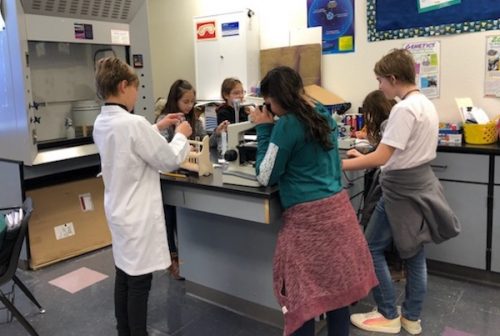
From left to right, Collette Fowlkes, Madison Cash, Ashley Certain, Daniela Fernandez, Charlotte Browning, Mabel Melgaard.
Proposal Summary:
In the experiment, “Eradicating Bacteria Growth in Microgravity,” we would like to explore if bacteria commonly found in the ISS (Bacillus subtilis), are tougher in microgravity or on Earth. Our question is: “Will using isopropanol to eradicate bacteria work more completely in microgravity than in gravity?” We hypothesize that the isopropanol will work more completely in gravity. In order to find out what will happen in this situation we will add isopropanol to a known concentration of bacteria. We will sterilize, then prepare the FME with freeze dried bacteria on one end with a clamp. The center section will contain a media broth (tryptic soy broth). The last section will contain isopropanol. Once the FME is in space, the astronauts will open clamp A to rehydrate the freeze dried bacteria, shake for 15 seconds, then open Clamp B to release isopropanol onto the bacteria. When the FME returns to Earth, we will calculate the number of bacterial colonies by plating the bacteria from the tube. We will incubate the plates for 48 hours and carefully count the number of bacterial colonies and compare that number to the one gathered here on Earth.
HONORABLE MENTION FINALISTS:
Bacterial Growth
Grades 5-6, Marfa Elementary School, Marfa Independent School District
Co-Principal Investigators: Noah Aguilar, Riley Sturman
Co-Investigators: Amaya Gomez, Marisa Hernandez
Collaborator: Kassandra Garcia
Teacher Facilitator: Connie Davidson
Proposal Summary:
Most regular liquid hand and body soaps contain chemicals, such as alcohol or chlorine, that can kill bacteria. Soaps that are labeled “antibacterial ” contain additional bacteria-killing chemicals such as triclosan or triclocarban. Testing the growth of bacteria when an antibacterial soap is present is the inquiry of this investigation. In this experiment, bacteria is transferred directly to a prepared test tube via a collection of saliva. The effectiveness of antibacterial soap will be tested by treating one side of the FME mini-lab with antibacterial soap and the other side of the FME mini-lab without soap. The effect of microgravity on bacterial growth will be measured by the diameter of the bacterial growth colony.
The Making of Antibiotics in Space
Grades 10-11, Marfa Jr/Sr High School, Marfa Independent School District
Co-Principal Investigators: Tais Chanez, Jared Fuentez, Isabella Morales, Kimberly Soto-Torres, Andrea Torres, Bryan Torres
Teacher Facilitator: Holly Blankenship
Proposal Summary:
Will humans be able to manufacture antibiotics on Mars? There are so many new discoveries being made in science everyday. Today, scientists are now genetically engineering yeast cells to manufacture antibiotics and recently, it has been discovered that baker’s yeast has antibacterial properties against streptococcus bacteria. Therefore, by selecting our experiment to go to space we hope to discover if microgravity will affect yeast fermentation and/or the growth of penicillium as a means for future antibiotic manufacturing. To get an answer to our question we will conduct a mini-lab experiment in space in which penicillium and bakers yeast will be combined with agar and allow to grow for approximately one week. Then, a fixative will be introduced to stop growth and preserve our results. Finally, upon return we will determine individual population size by bisecting the FME and examining the cells under the microscope. Comparing cell count of the two species will determine whether they can effectively work together to produce antibiotics.
36. Pharr, Texas
Jump to Pharr’s Community Profile
SELECTED FOR FLIGHT:
What are the Effects of Microgravity on the Cellular Growth of Spinacia oleracea?
Grade 11, PSJA Thomas Jefferson Early College High School T-STEM, Pharr-San Juan – Alamo ISD
Principal Investigator: Joahna Evasco
Co-Investigators: Nolberto Cortez, Rachel Martinez
Collaborator: Diego Tijerina
Teacher Facilitator: Roxanne Ruelas
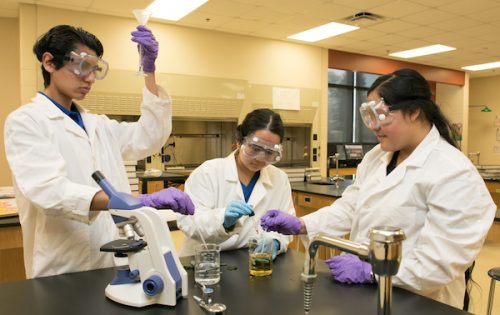
The selected Student Spaceflight Experiment team from PSJA Thomas Jefferson T-STEM Early College High School conduct a ground trial for an experiment studying the effects of microgravity on the growth of Spinacia oleracea seeds.
Proposal Summary:
The proposal for this experiment is to determine how microgravity affects the growth of Spinacia oleracea seeds. Under normal growth, Spinacia oleracea responds to the external stimuli of gravity by resisting and growing in the opposing direction. Spinacia oleracea, in natural conditions has roots that grow towards the center of the Earth in the direction that gravity is pulling. What will happen to its cells if it is exposed to microgravity? Cellular chemical reactions are affected by gravity, this plays a key role on molecules that control cellular processes like growth and division (Tay, 2017). How will the cells respond towards a microgravity environment, what will the end result be on the anatomy of Spinacia oleracea cells, and what will the end result be for the whole experiment? The plan for this experiment is to use distilled water, felt, Spinacia oleracea seeds and Formalin. The experiment will require a Type 3 FME Mini-lab. Volume 1 will contain seven Spinacia oleracea seeds encased within cotton balls for the germination process. Volume 2 will contain 1.5 mL of distilled water. Volume 3 will contain Formalin to preserve and to stunt the growth of the Spinacia oleracea. When the experiment is completed, its cells will be observed to see any anatomical changes and root cells will be viewed under a microscope to see any changes of the cells compared to a regular Spinacia oleracea.
HONORABLE MENTION FINALISTS:
Lactose Breakdown by using Lactase Enzymes
Grade 11, PSJA Thomas Jefferson Early College High School T-STEM, Pharr-San Juan – Alamo ISD
Co-Principal Investigators: Ana Torres, Leonel Watts
Co-Investigators: Kenya Perez, Guadalupe Marquez
Teacher Facilitator: Israel Soria
Proposal Summary:
Metabolism is the process in which our body breaks down carbohydrates, also known as chemical reactions. In order to break down sugars, our body uses catalysts named enzymes. Most enzymes are proteins, which are composed of monomers named amino acids. In the enzyme, there is a location in which a substrate (molecule that the enzyme will break down) must fit so that the enzymes convert the sugar into a simple sugar, which will be the product of the chemical reaction. In this experiment we will like to see the effects of enzymes in lactose under microgravity. We will be using a product that contains lactose (milk, cheese, cream), and add a pill of lactase enzymes that will help break down lactose into a simple sugar. It is known that some people have faster metabolism than other people on Earth, but could chemical reactions in our body be faster in space?
How does Microgravity Affect the Diffusion of Molecules through a Semipermeable Membrane?
Grade 11, PSJA Thomas Jefferson Early College High School T-STEM, Pharr-San Juan – Alamo ISD
Co-Principal Investigators: Anthony Barreiro, Desteny Duran, Gemal Quintanilla
Teacher Facilitator: Israel Soria
Proposal Summary:
The semipermeable membrane that lines human cells, has been studied in thousands of classrooms all throughout the world. Each year students are taught that these phospholipid bilayers control what exits and enters our cells. However, if molecules that are necessary for carrying out bodily functions are not able to pass at normal rates in an environment with microgravity, today’s astronauts may be unaware of the changes (and possible threats) that space may pose on their biological processes. By conducting this experiment, we are determining the effects that microgravity has on the diffusion of molecules through a semipermeable membrane. In turn, we can learn more about whether or not microgravity alters the normal rate of diffusion and if there are even more risks for astronauts that have been unaccounted for. This experiment will require dialysis tubing (semipermeable membrane), string, iodine, starch, water and a filter. The Type 2 FME will have a clipped dialysis tubing bag filled with 1.5 mL of starch, with a filter right below it, placed in Volume 1 and 5.5 mL of a water-iodine solution in Volume 2. When the clamp is removed, we will shake the tube so that the membrane becomes immersed in the solution. After 60 seconds, we will reclip the FME so that the starch and solution are separated once again. This process will be repeated on five different days, both on Earth and in space in order to compare the results.
37. Raleigh County, West Virginia
Jump to Raleigh County’s Community Profile
SELECTED FOR FLIGHT:
Effects of Microgravity on the Growth of Caulobacter Crescentus
Grades 11-12, Shady Spring High School, Raleigh County School District
Principal Investigator: requires permissions for student names
Co-Investigators: requires permissions for student names
Collaborators: requires permissions for student names
Teacher Facilitator: Elizabeth Hegele
Proposal Summary:
Caulobacter crescentus is a unique oligotrophic bacterium that produces an incredibly strong adhesive. This natural “super-glue” is being researched by material scientists in order to develop new technologies for medical and engineering purposes. An easily manufacturable adhesive could prove to be valuable in long-term space travel and colonization. The adhesive has biodegradable qualities, making it a candidate for the replacement of sutures and staples in surgery, and its strength could make it very useful in construction and engineering. The goal of our team’s experiment is to study the effects of microgravity on the growth of a colony of Caulobacter crescentus by activating the freeze-dried bacteria in orbit so the colony can grow, then using a preservative solution to stop the growth until its return to the community, where the results will be compared to a control experiment conducted on Earth. We believe that when the mass production of this bacterium-based glue becomes viable, our experiment will help provide a better understanding of how the bacteria growth changes within a microgravity environment, so that future technologies can be implemented into and produced within such an environment.
HONORABLE MENTION FINALISTS:
Virulence Rate of the Tobacco Mosaic Virus After Being Under the Influence of Microgravity
Grades 10-12, Shady Spring High School, Raleigh County School District
Principal Investigator: requires permissions for student names
Co-Investigators: requires permissions for student names
Teacher Facilitator: Elizabeth Hegele
Proposal Summary:
According to information obtained from results of an experiment done by Cheryl Nickerson, bacteria has a higher virulence rate in space as opposed to Earth. This is mainly due to gene expression of the bacteria caused by radiation. To further the research on how microbes behave in space, we want to focus on the Tobacco Mosaic Virus, a virus that affects over 350 plant species. There will be two groups: a control group and experimental group. The control group will be the plants inoculated with the virus that stayed on Earth, and the experimental group will be inoculated with the virus sent to space. Both groups will have a constant setup, conditions, and the same procedures. In the first chamber of the tube provided, we will put deionized water to reconstitute the lyophilized virus. In the second chamber, the lyophilized sample of the virus will be placed. In the third chamber, ViveST will be used to preserve the virus. Three Tobacco Mosaic Virus Infectivity Assay Kits will be purchased from Carolina Biological Supply Company. After the kits are received, 50 pinto bean plants will be planted for both groups in 9-10 days prior to the virus arriving back to Earth. After the plants are grown and the virus is received, inoculation will begin. Inoculation will take 4-5 days to show evidence of disease. All evidence of diseased plants and the rate of time of which the plant is infected will be recorded for both groups. The two results will be compared.
A Comparison of the Effect Microgravity has on the Elasticity of CVD Graphene on a Si02/Si Wafer and a 1cm x 1cm Conductive Graphene Sheet
Grades 10 and 12, Shady Spring High School, Raleigh County School District
Principal Investigator: requires permissions for student names
Co-Investigators: requires permissions for student names
Teacher Facilitator: Elizabeth Hegele
Proposal Summary:
In this project, we would place a Chemical Vapor Deposition (CVD) graphene sample on a Si02/Si wafer in volume 1 of the Type 2 FME Mini-Lab and place a 1 cm x 1 cm graphene sheet in volume 2. Once the samples of graphene are returned to Earth, the masses of the samples will be compared to each other and to the samples that remained on Earth. We will then compare pre and post optical images to see if there are more fractures in the samples after they returned to Earth. This project is important because no other country has taken graphene into space. If the graphene samples resist the effects of microgravity, then it can be used in conductor pipes and serve as a productive coating for satellites. We are comparing the CVD graphene to the graphene sheet to determine which will be more applicable for future spaceflight. Researchers observed that, “the loading of graphene nano platelets with SiO2 nanoparticles enhances the photocatalytic efficiency from 46% to 99%”(Arshad, Iqbal, Mansoor, Ahmad, 2017). The ability of SiO2 to increase the flow of electrons will make graphene a more effective conductor. Graphene is a less expensive building material and is lightweight. “A single square-meter sheet of graphene would weigh just 0.0077 grams could support up to four kilograms. No known material can approach this combination of abilities” (Templeton, 2013). Research shows “Lighter Spacecrafts can have smaller, more efficient engines and less fuel. This in turn, saves more weight savings and cost reduction” (NASA, 2002).
38. iForward – Grantsburg, Wisconsin
Jump to iForward’s Community Profile
SELECTED FOR FLIGHT:
What Happens to the Germination of Solanum lycopersicum ‘Red Velvet’ Seeds in Microgravity?
Grades 9-11, iForward Public Online Charter School, Grantsburg School District
Co-Principal Investigators: Sella Benzing, Jessica R. Ojeda-Barojas, Lily Olson, Holly Orth
Teacher Facilitator: Laura Kavajecz
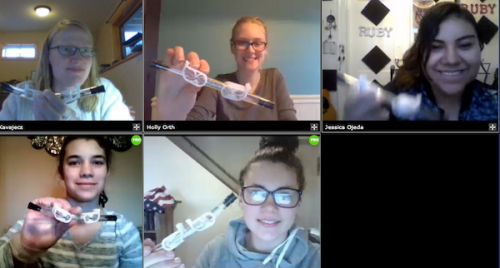
iForward students and staff running experimental trials collaboratively online from across the state of Wisconsin. Mrs. Laura Kavaczak (top left), Holly Orth (top middle), Jessica Ojeda (top right), Stella Benzing (bottom left) Juniann Bartholomew (bottom middle).
Proposal Summary:
Our experiment will test the germination of Solanum lycopersicum ‘Red Velvet’ in microgravity. This variation of tomato is the popular food source, known as the cherry tomato, appreciated for its sweet taste and small size. The purpose of our experiment is to determine whether the Solanum lycopersicum ‘Red Velvet’ seeds can germinate correctly in a microgravity environment. Our experiment will use a three chamber fluid mixture enclosure (FME) set up. Volume one will be filled with 2.0 milliliters of distilled water, the second volume will contain 2.8 milliliters of vermiculite and six Solanum lycopersicum ‘Red Velvet’ seeds, and the third chamber will contain 2.8 milliliters of 10% neutral buffered formalin. If Solanum lycopersicum can germinate in microgravity, this could result in a new plant for astronauts to grow in space and this could be especially helpful in missions that are a longer duration, which require more food, because this plant could potentially be grown successfully, during flight.
HONORABLE MENTION FINALISTS:
Does Microgravity Affect the Efficacy of Antibiotics?
Grade 8, iForward Public Online Charter School, Grantsburg School District
Co-Principal Investigators: Anita Finch, Ava Hazard, Andrew Nichols
Co-Investigators: Cody Fuher, Damia Sargent, Hannah VanDeLeygraaf
Teacher Facilitator: Andrea Konrath
Proposal Summary:
Our experiment seeks to determine if there will be a change in the efficacy of antibiotics in a microgravity environment. We plan to send up a type 2 FME with each chamber containing several paper discs impregnated with two different amounts of Amoxicillin. When our experiment returns, we will be testing the impregnated filter discs on laboratory samples of both Escherichia coli and Bacillus subtilis. We will test the potency by conducting a Kirby Bauer assay, to compare the zones of inhibition. Previous studies have found that antibiotics grow larger and more perfect protein crystals in space (Fajardo-Cavazos, et. al.; Benoit). One possible explanation for this may be related to the reduction of shear stress in microgravity. With less friction, the antibiotics are free to move around, rather than rest inside the FME tube. Therefore, we hypothesize that they will also become more potent. We know that antibiotics are used to treat a variety of bacterial infections. Furthermore, many common infections are mutating to become resistant to our current antibiotics (CDC). We also know that our current antibiotics are not as effective in treating bacterial infections in astronauts in space (Fajardo-Cavazos, et. al.; Benoit). If antibiotics continue to prove to grow better and stronger in microgravity, this could have far-reaching implications as far as treating infections in space and creating stronger, less resistant antibiotics on Earth.
Does the Near Space Environment Cosmic Radiation Have Sufficient Energy to Transmute Gold?
Grades 9-11, iForward Public Online Charter School, Grantsburg School District
Co-Principal Investigators: Jessica R. Ojeda-Barojas, Lily Olson
Co-Investigators: Sella Benzig, Holly Orth
Teacher Facilitator: Laura Kavajecz
Proposal Summary:
The main question being asked by this experiment is, “does the near space environment cosmic radiation have sufficient energy to transmute gold?” Gold is a common metal found in the periodic table with the atomic number 79, atomic symbol Au and an atomic mass of 196.966569. Gold has many unique and useful properties including malleability, ductility, conductivity and heat reflection. Transmutation is the change into another form or condition. This experiment is proposing to test if gold transmutes when it is exposed to near space cosmic radiation. We want to find out if the higher levels of radiation on the International Space Station (ISS) will cause any atomic changes. Because gold foil is so thin and there are not too many layers of atoms in it each atom would be exposed to a good amount of radiation on the ISS. This experiment could provide clues as to how elements and metals are impacted by the higher levels of cosmic radiation on the ISS. The expectation is that there will be a difference between the radiation levels experienced by the ground control sample and the sample that is sent to the ISS. Hopefully, analysis of this experiment will provide a clearer answer as to how gold is affected by cosmic radiation found in the microgravity environment on the ISS and lead to further research in the field of cosmic radiation and its effect on various metals.

